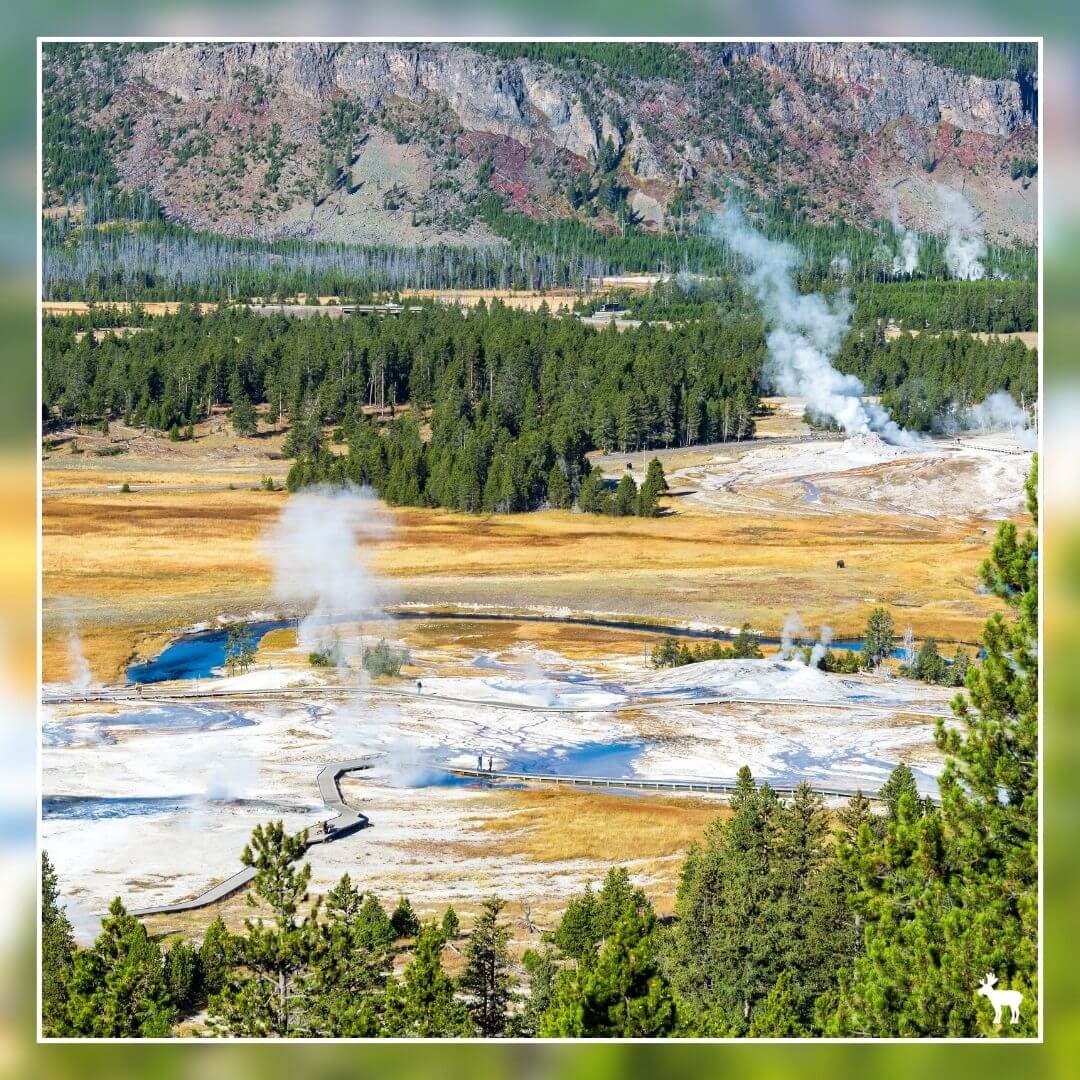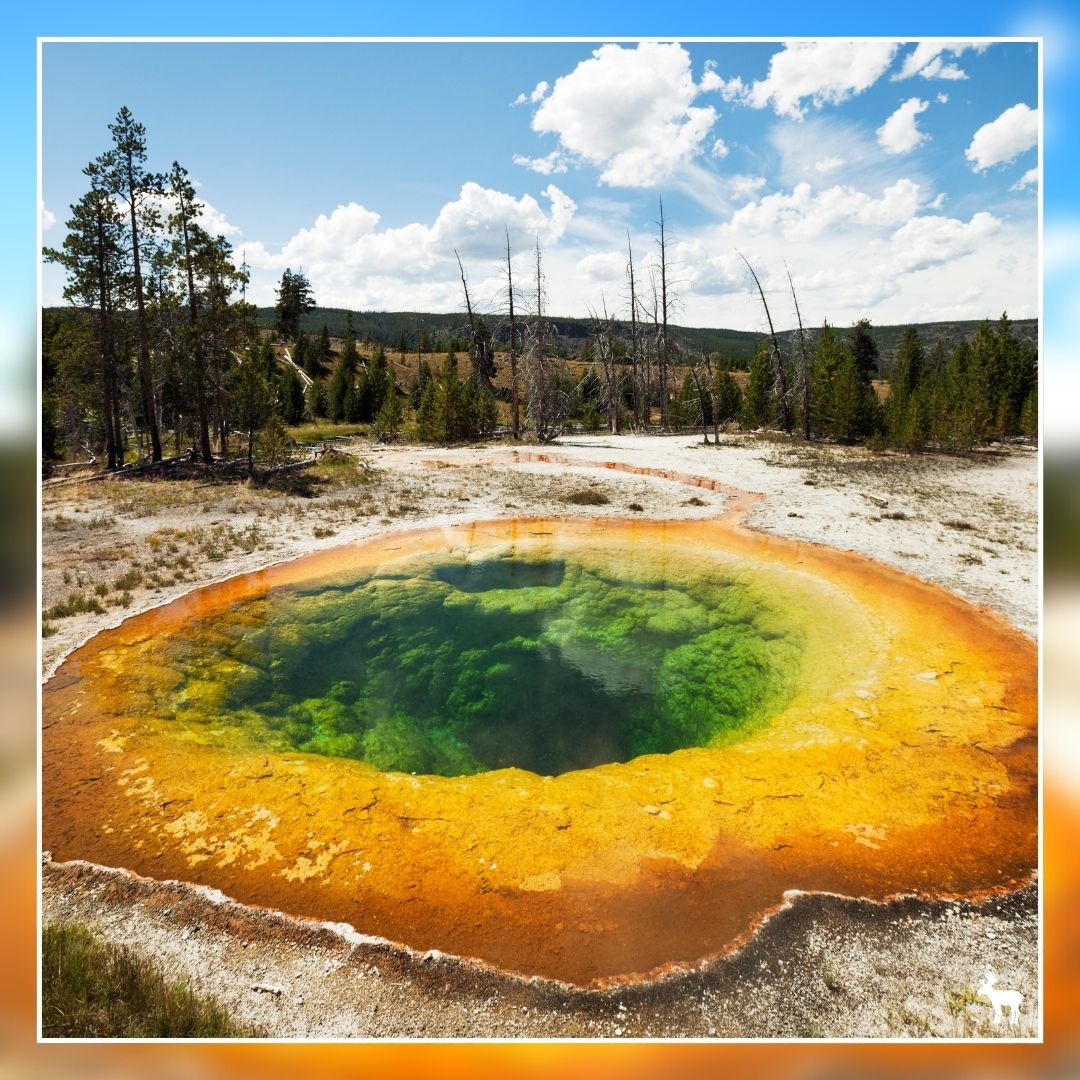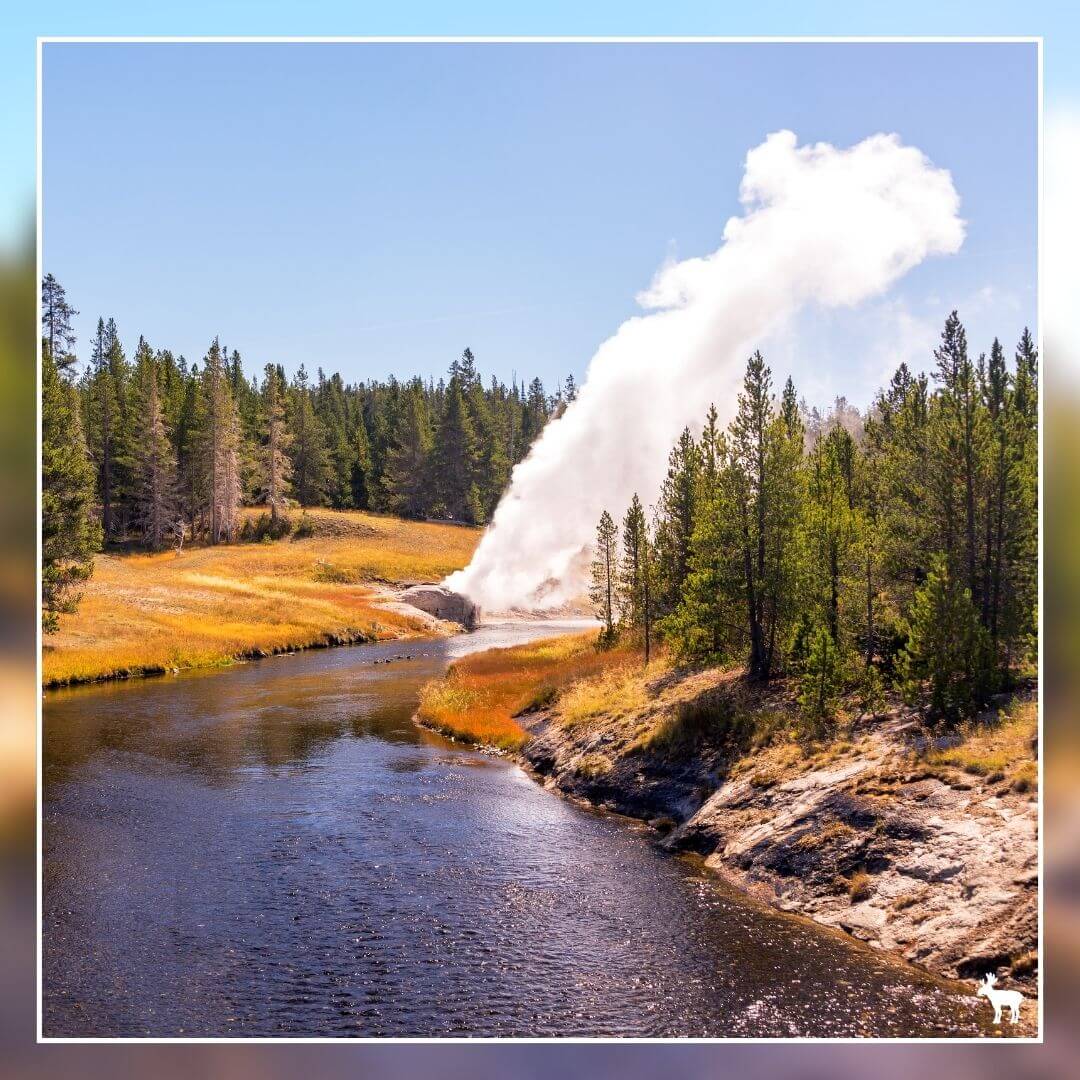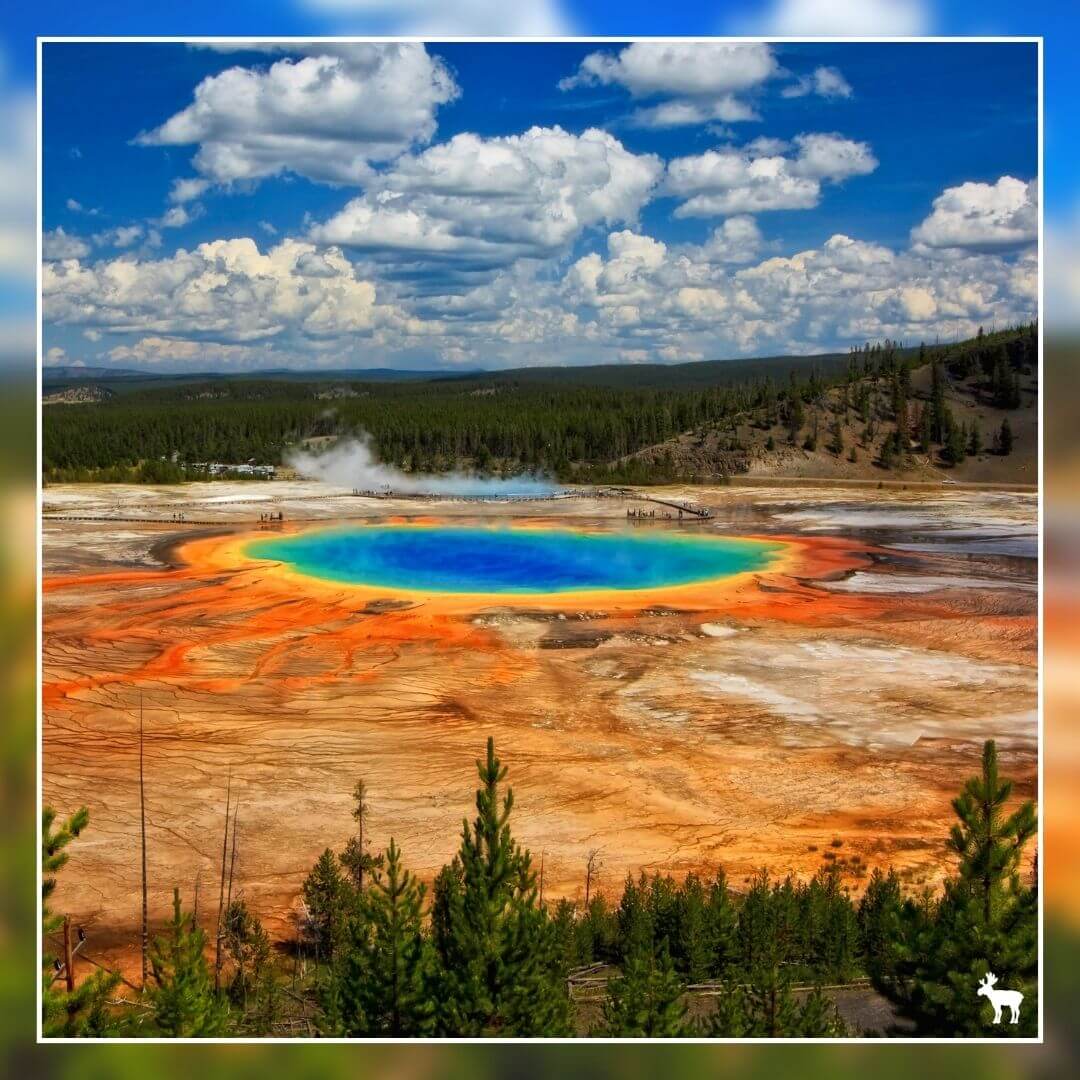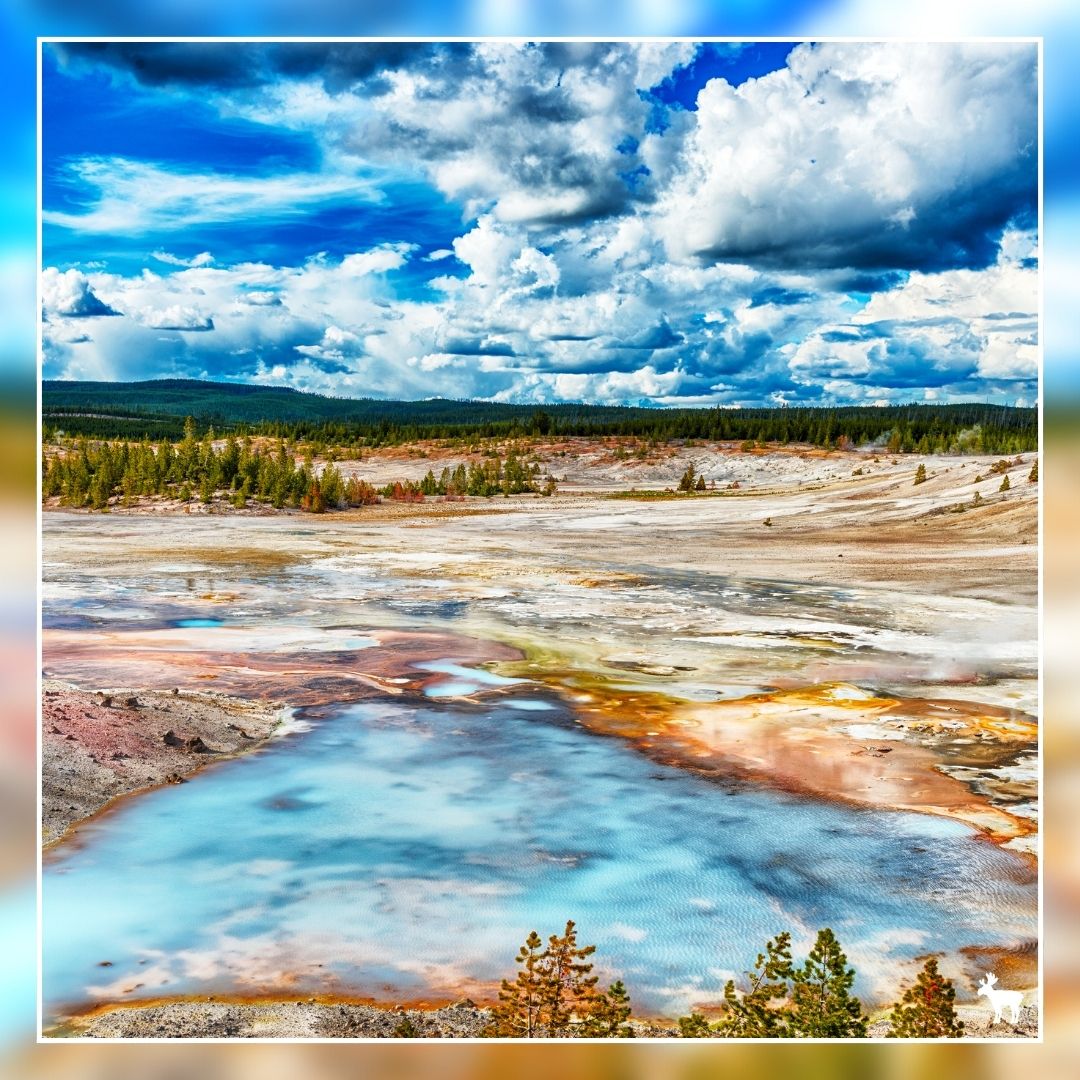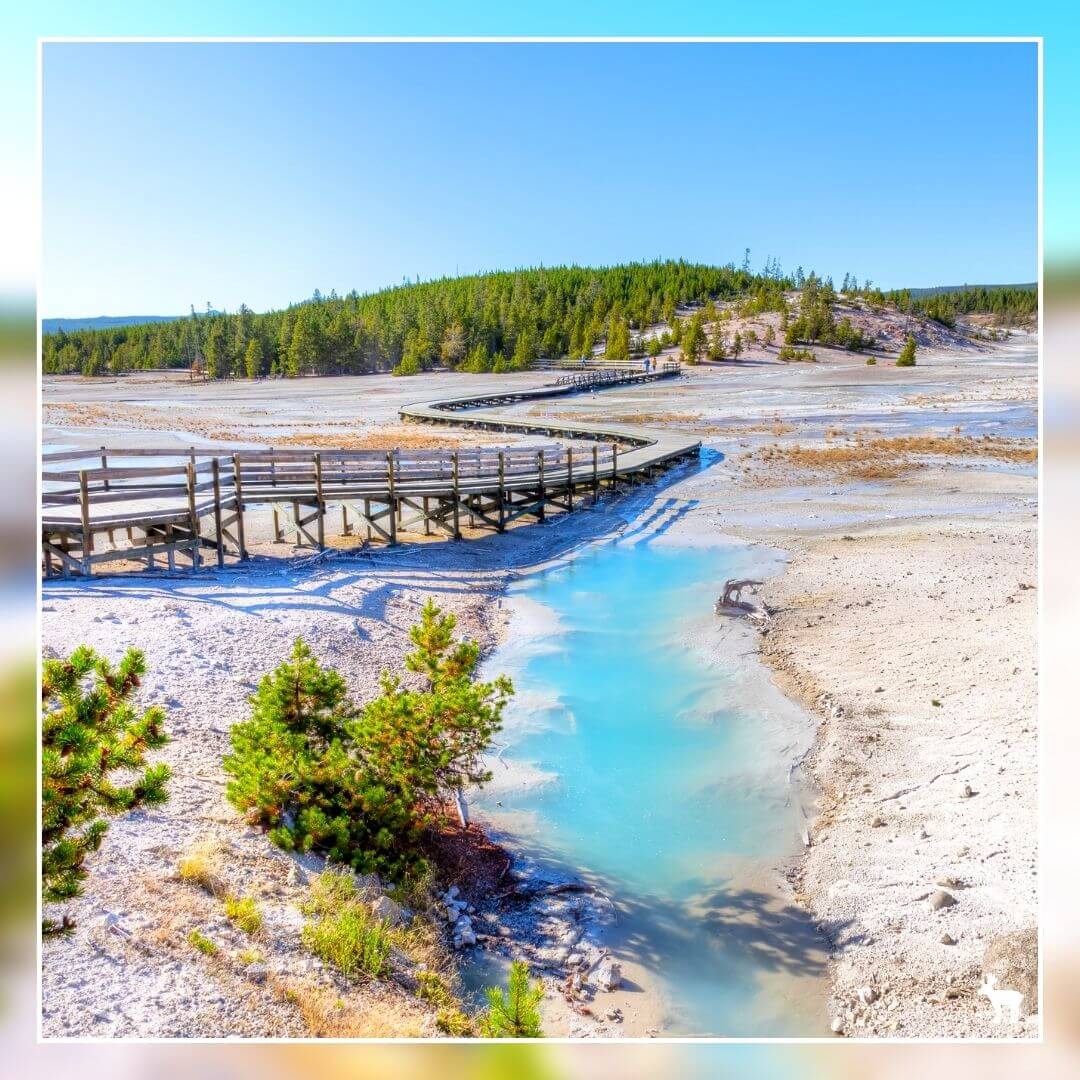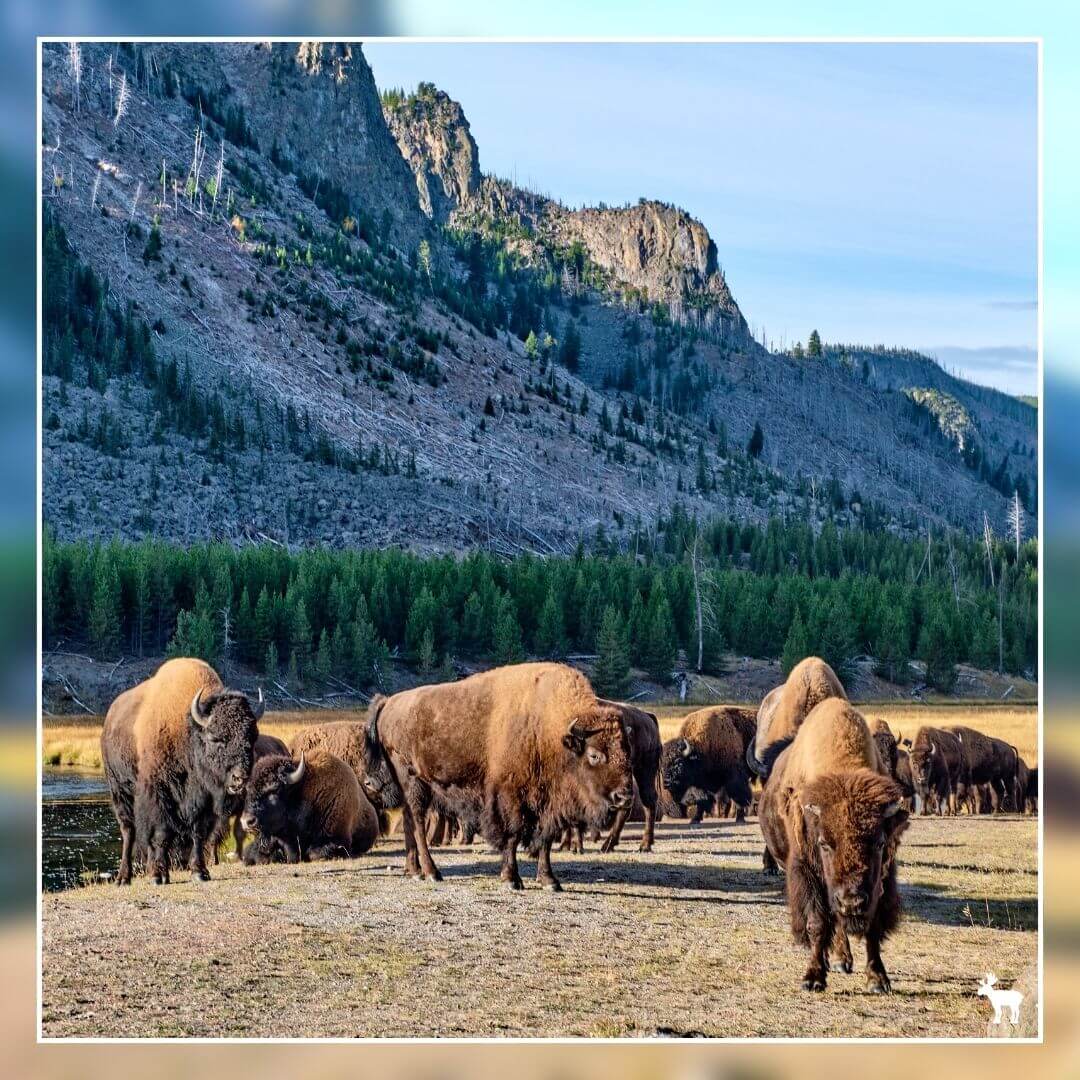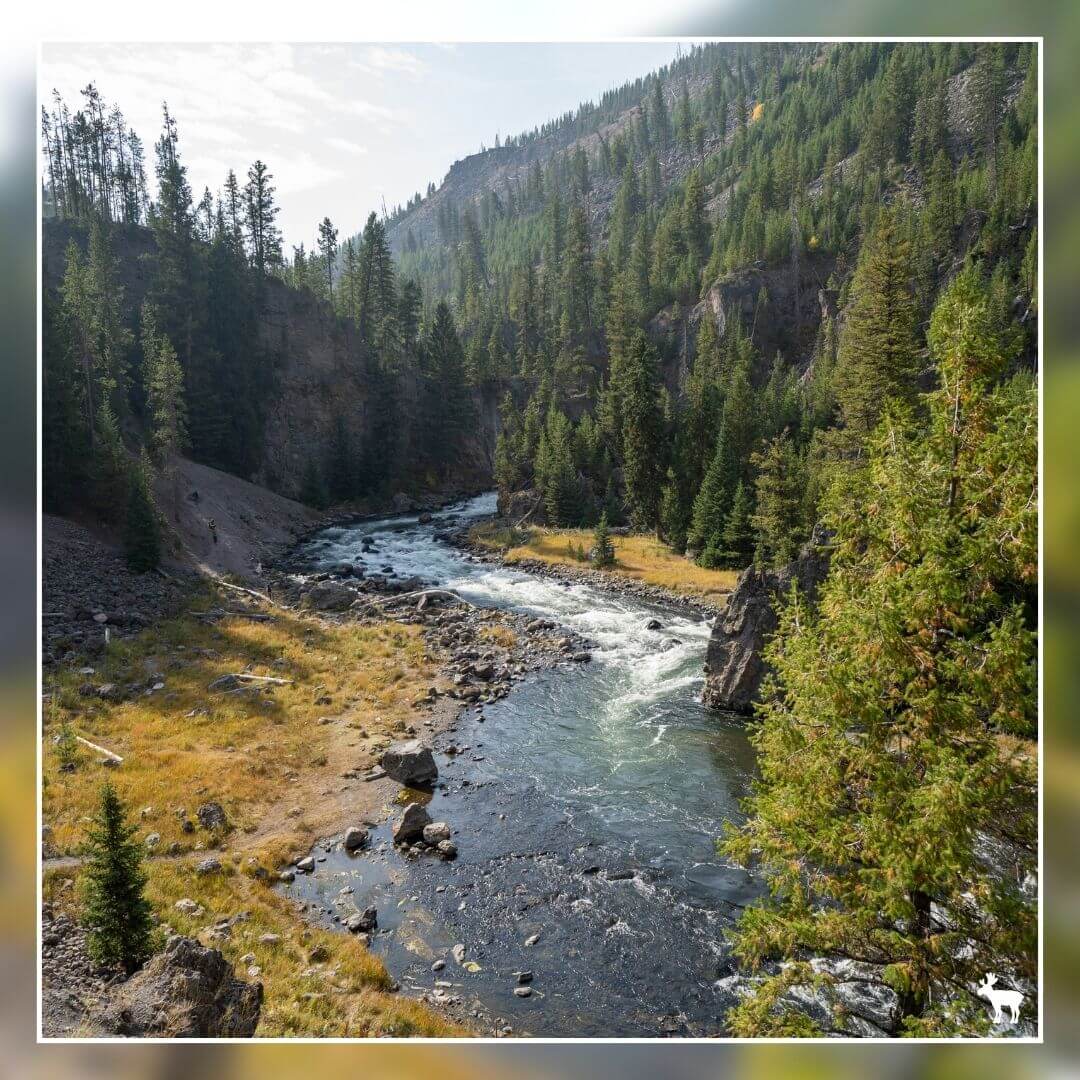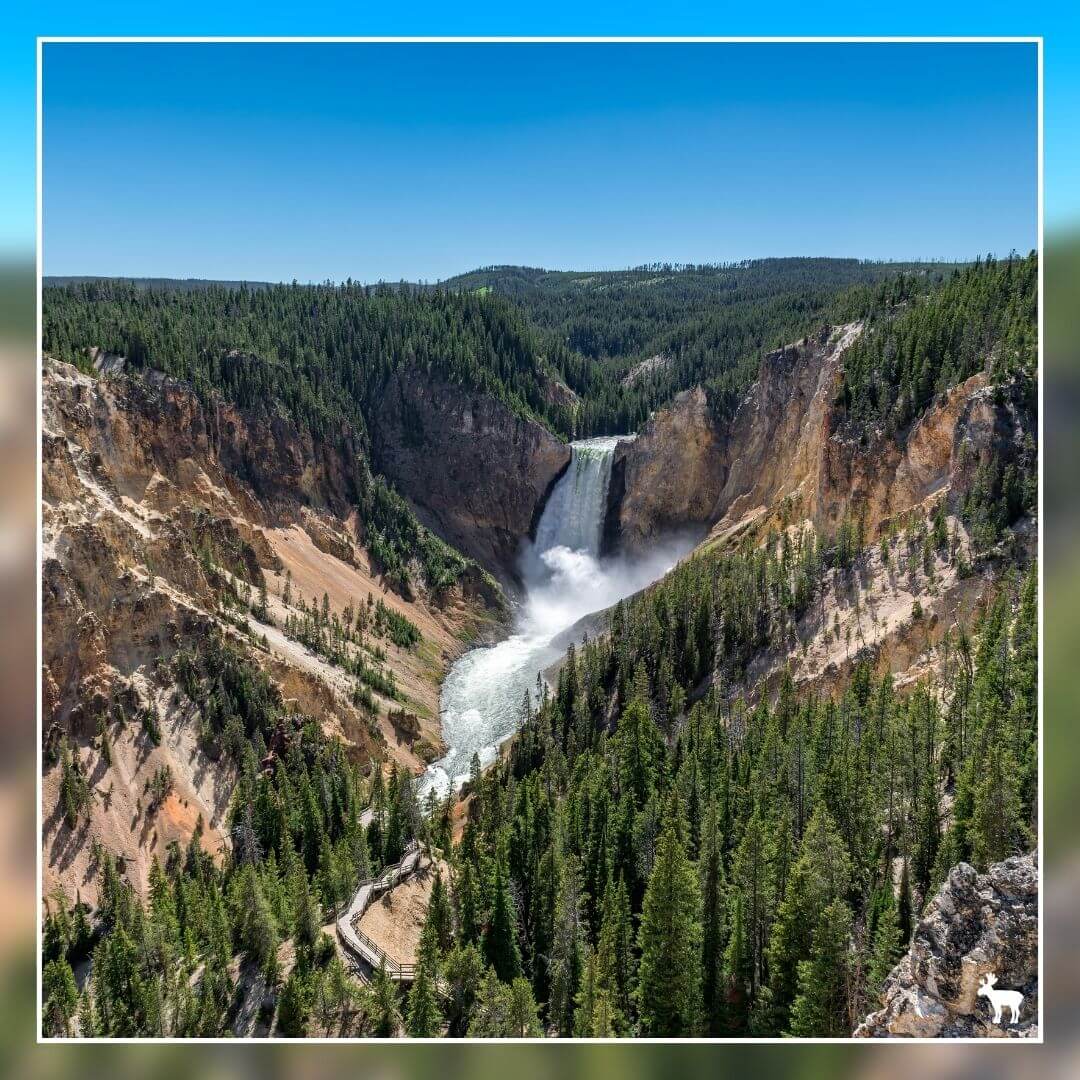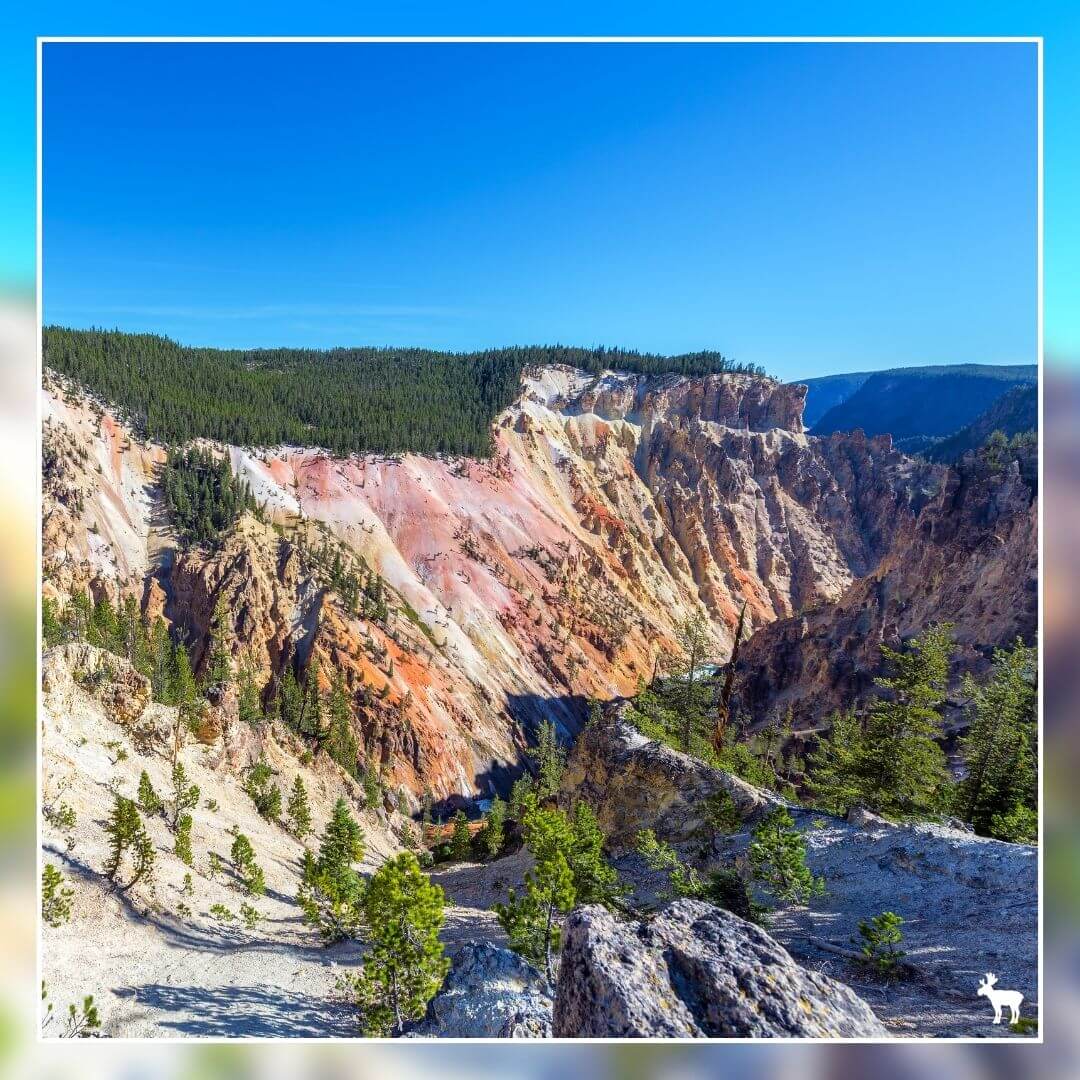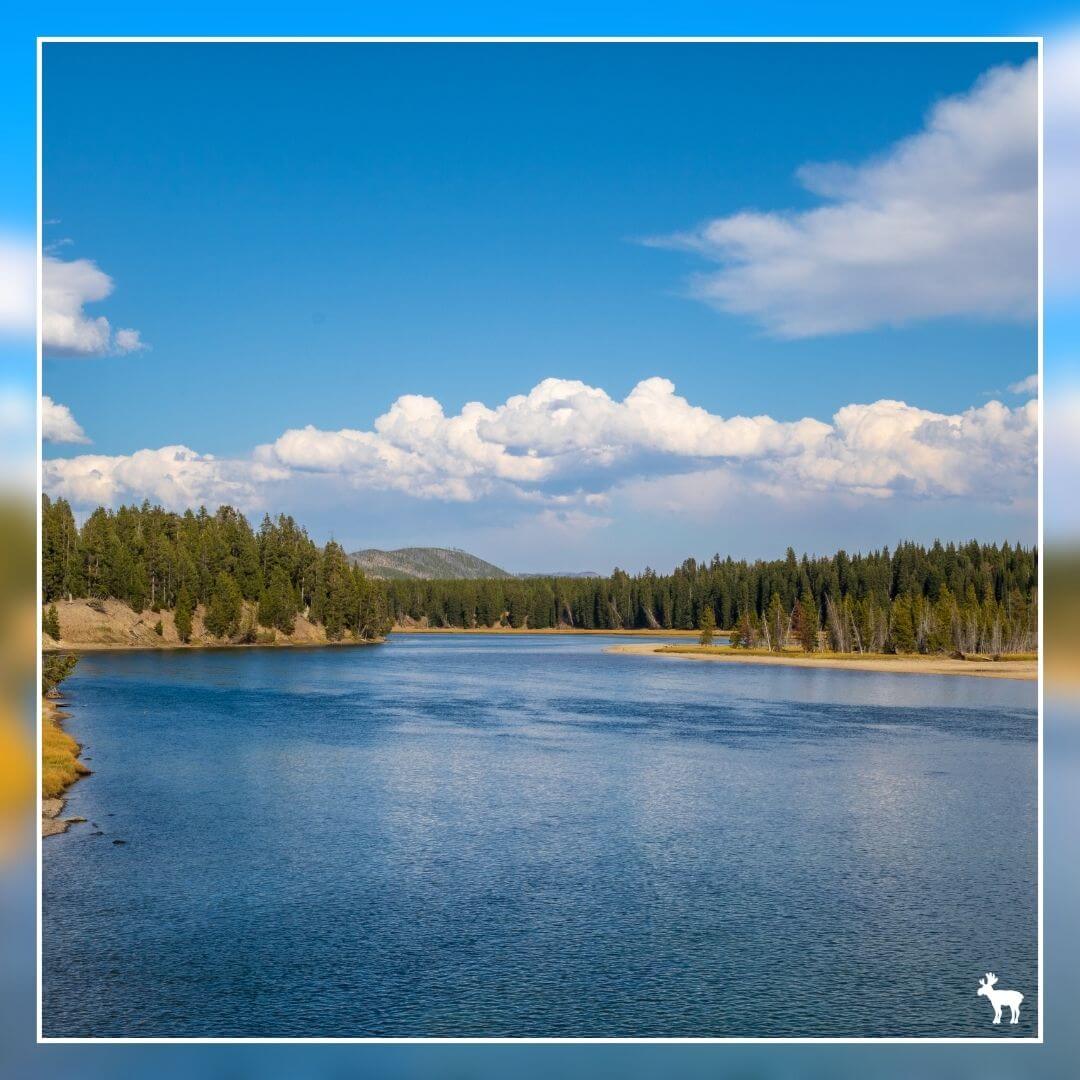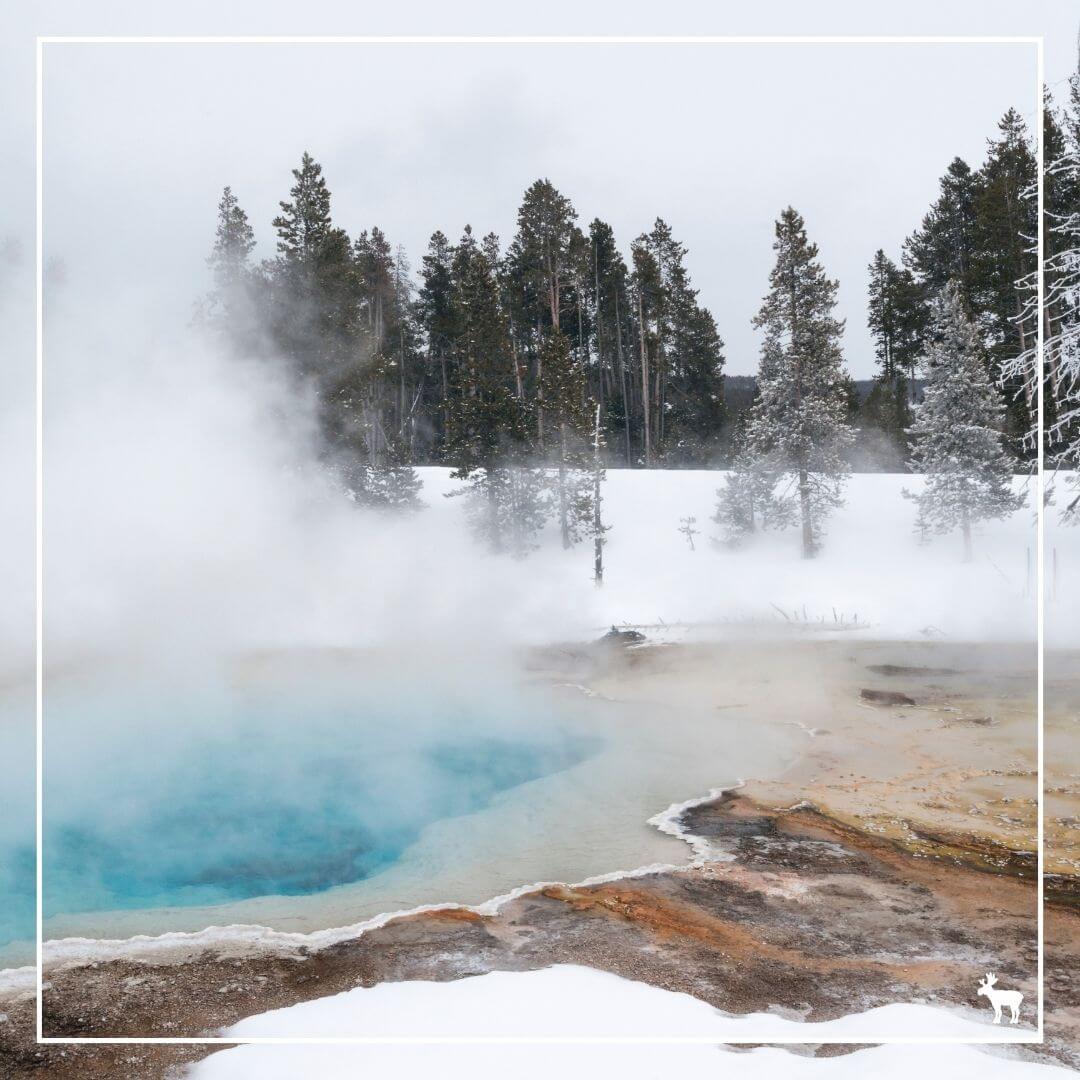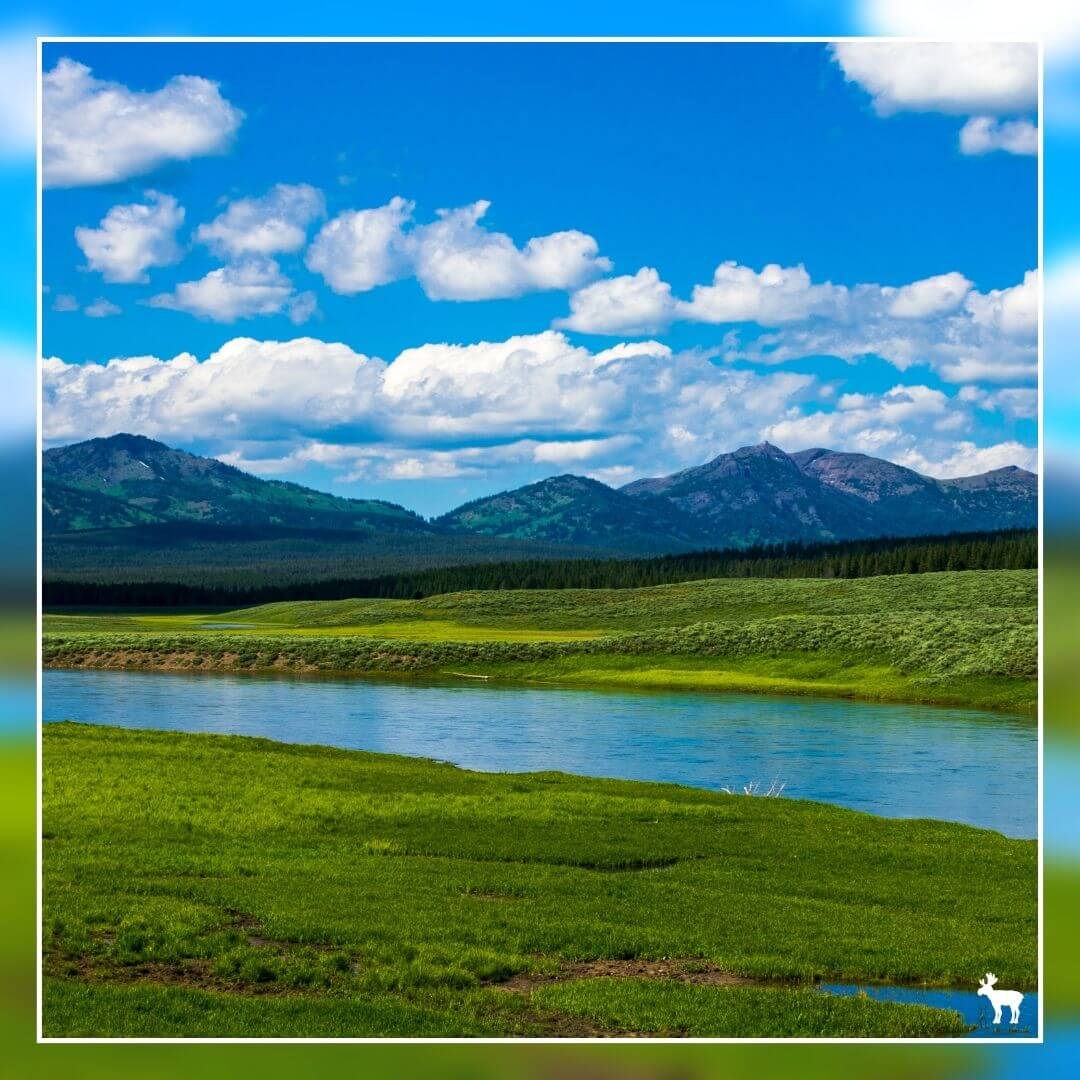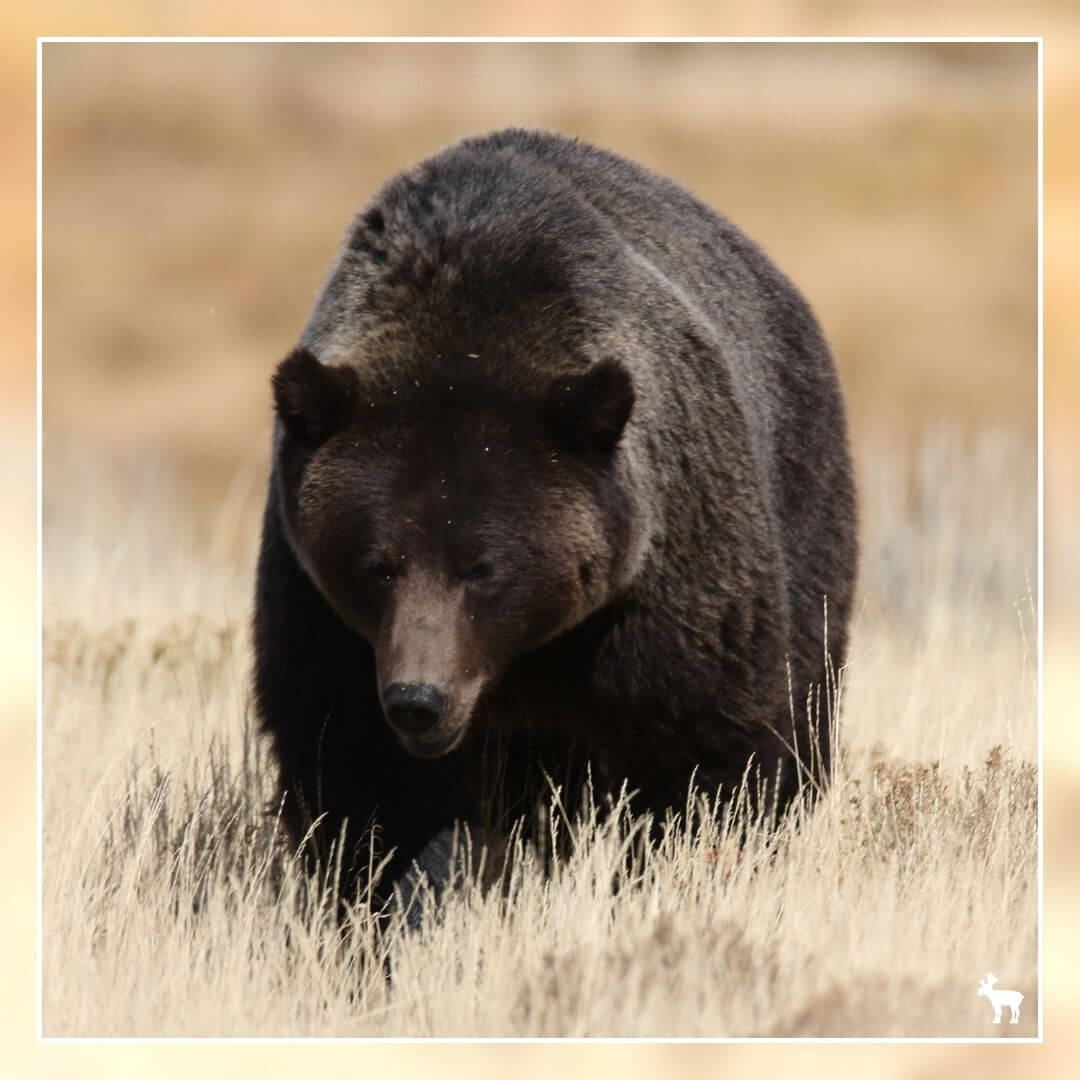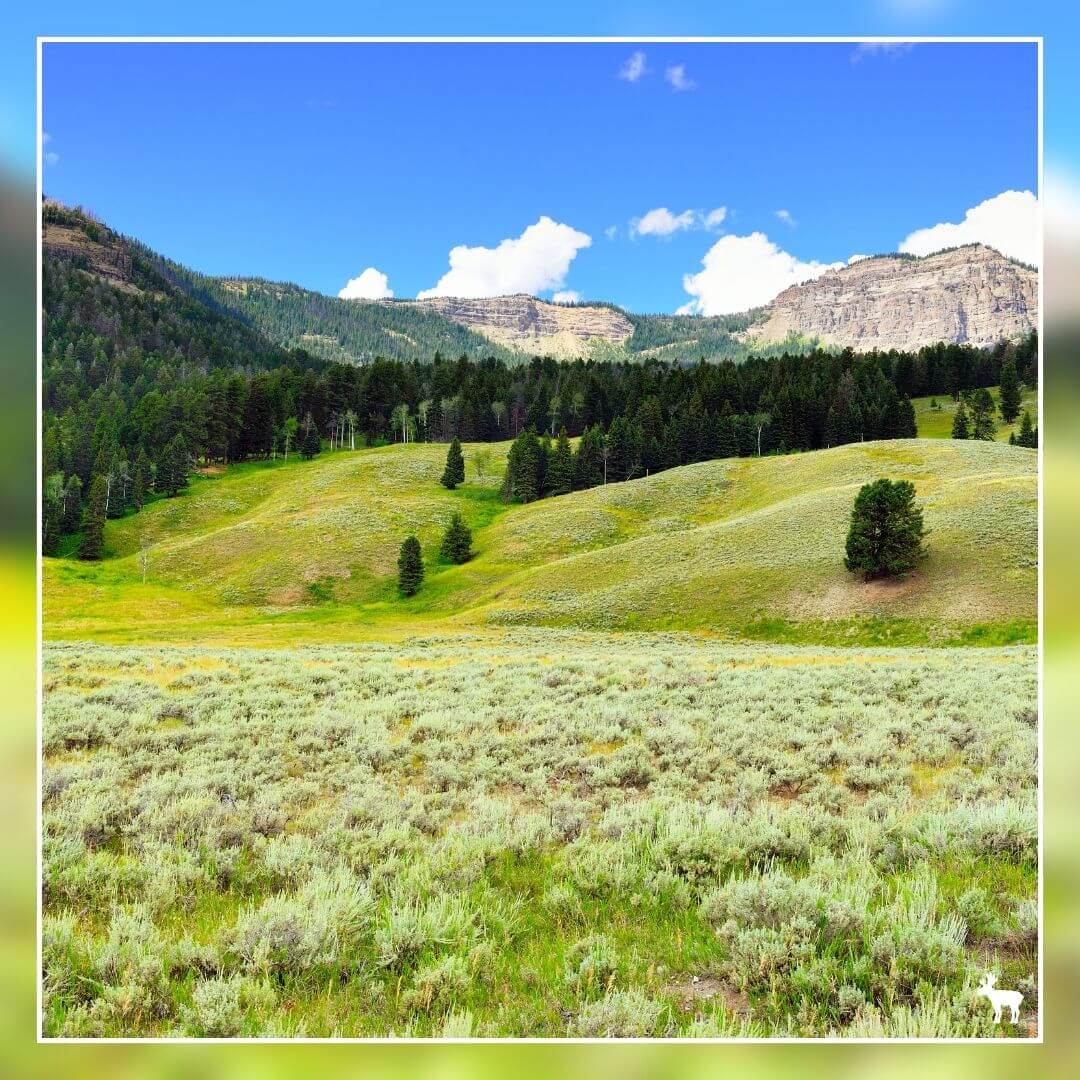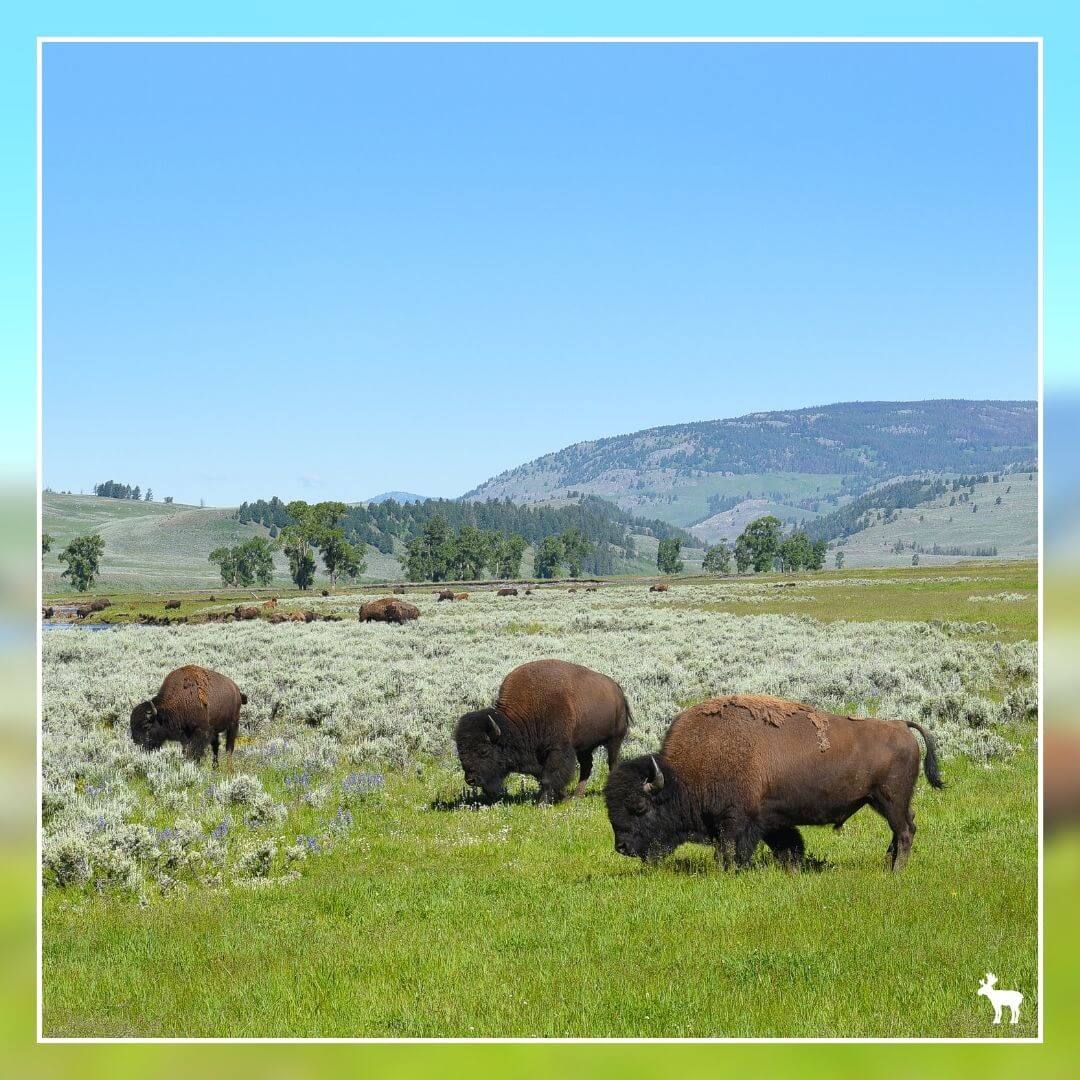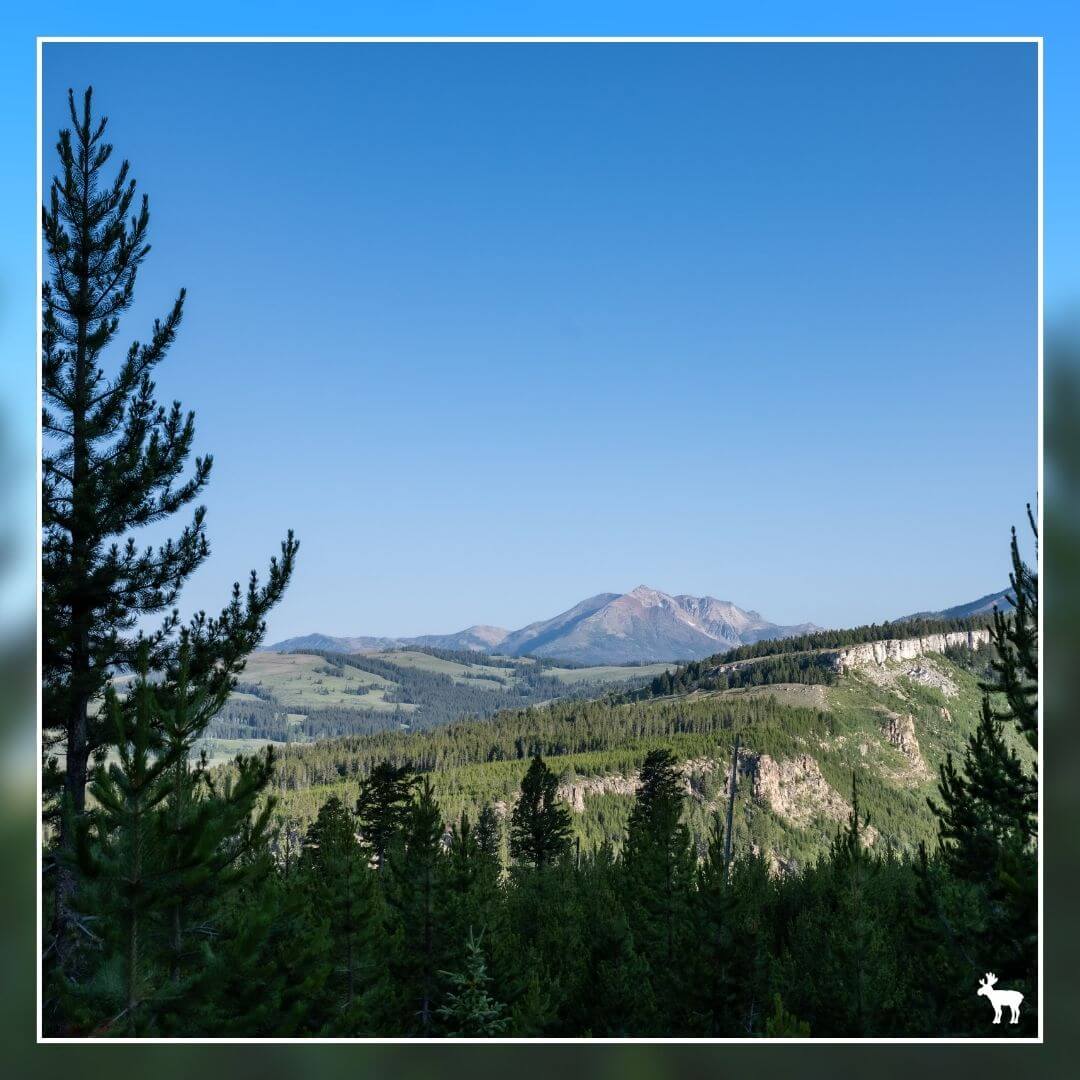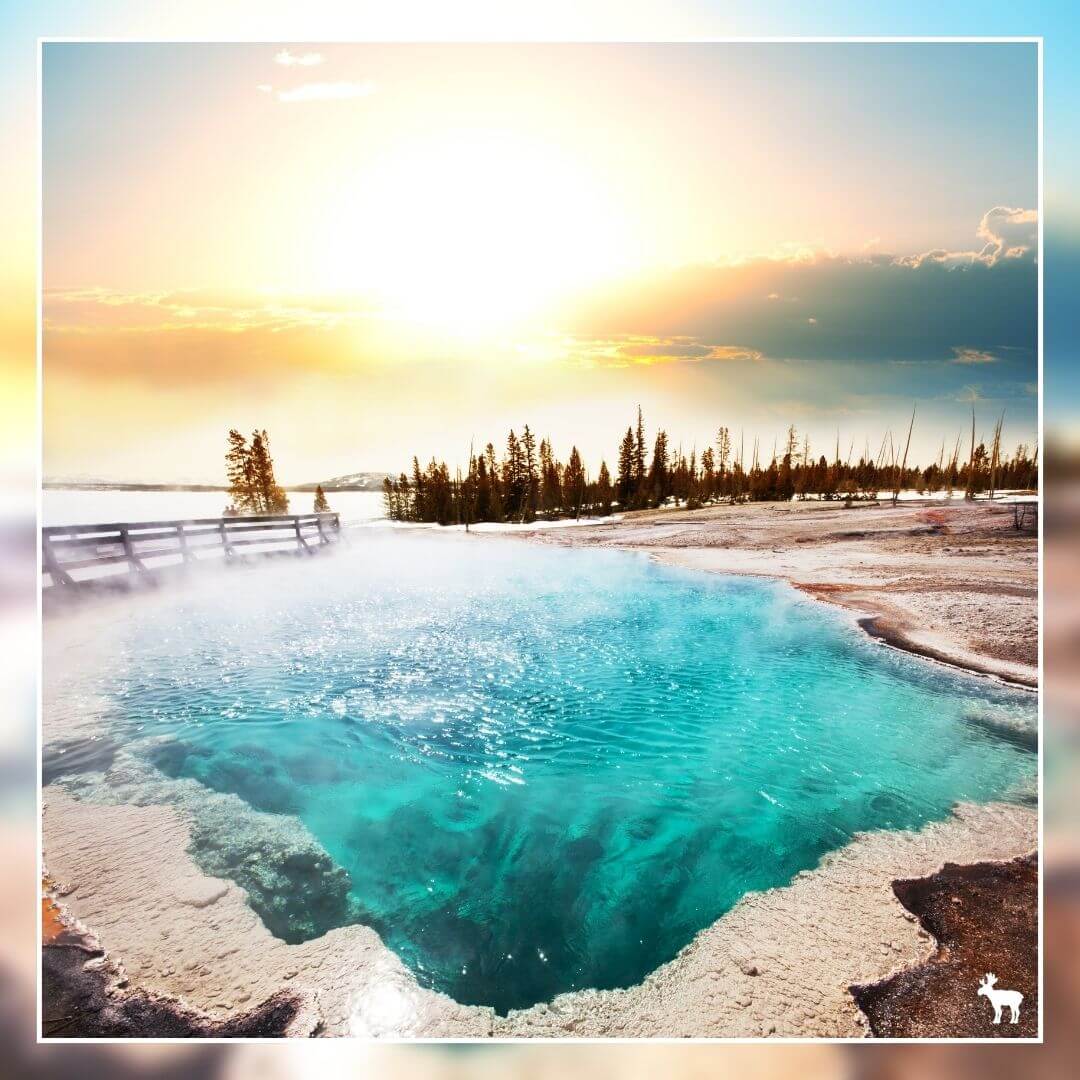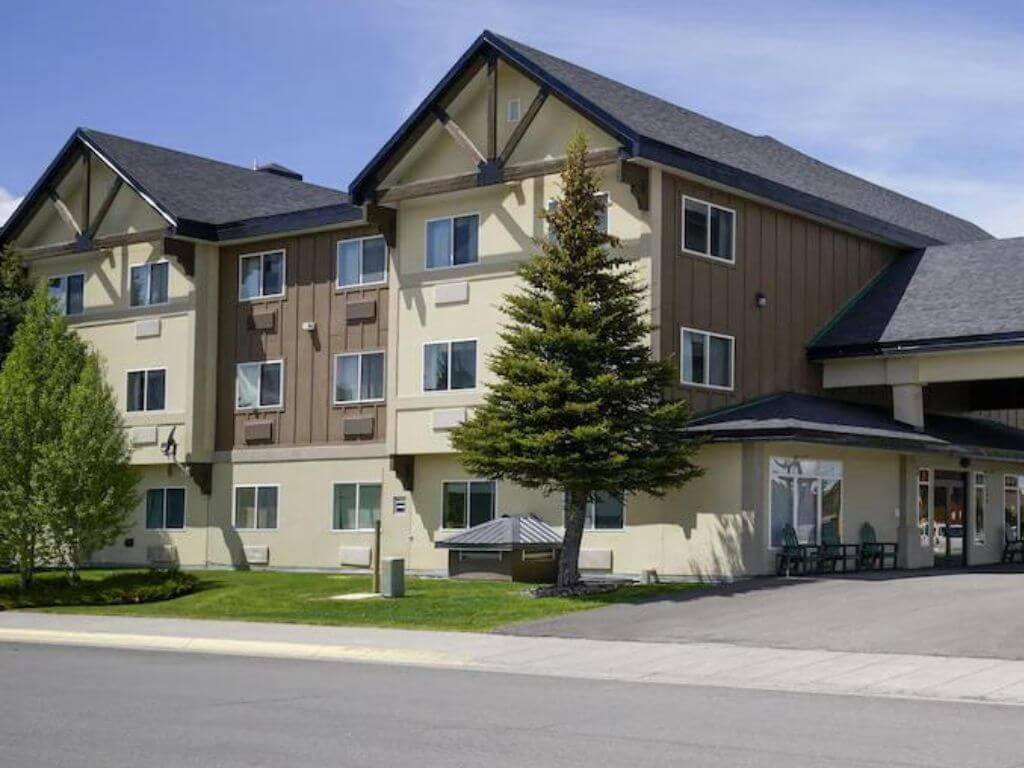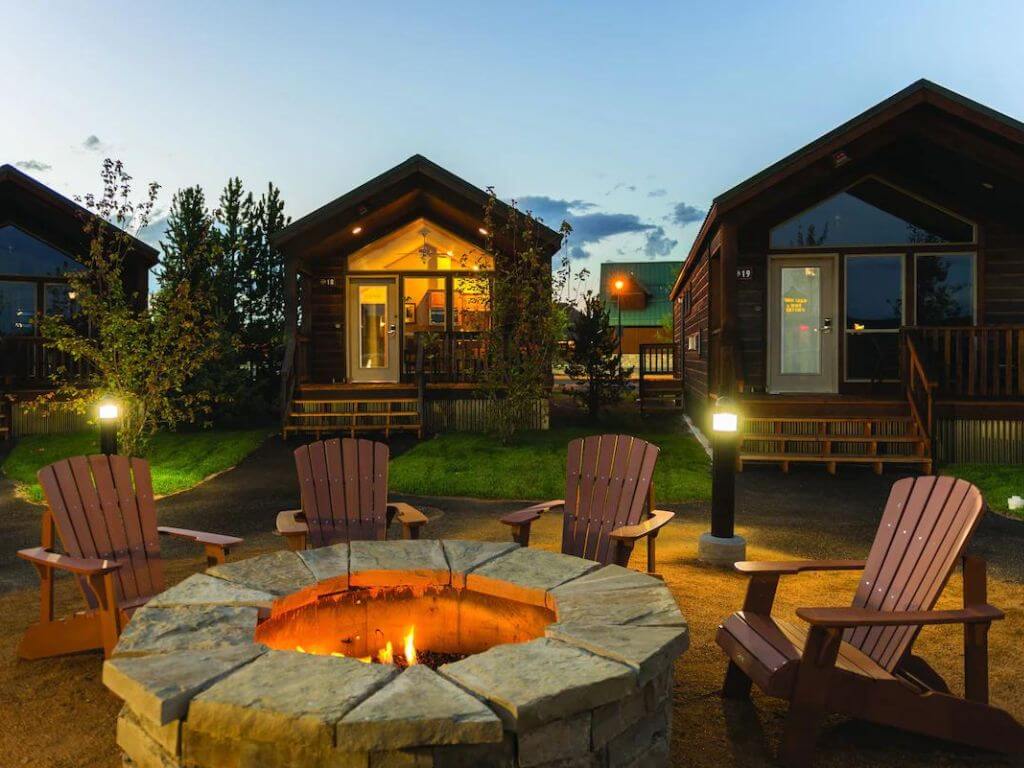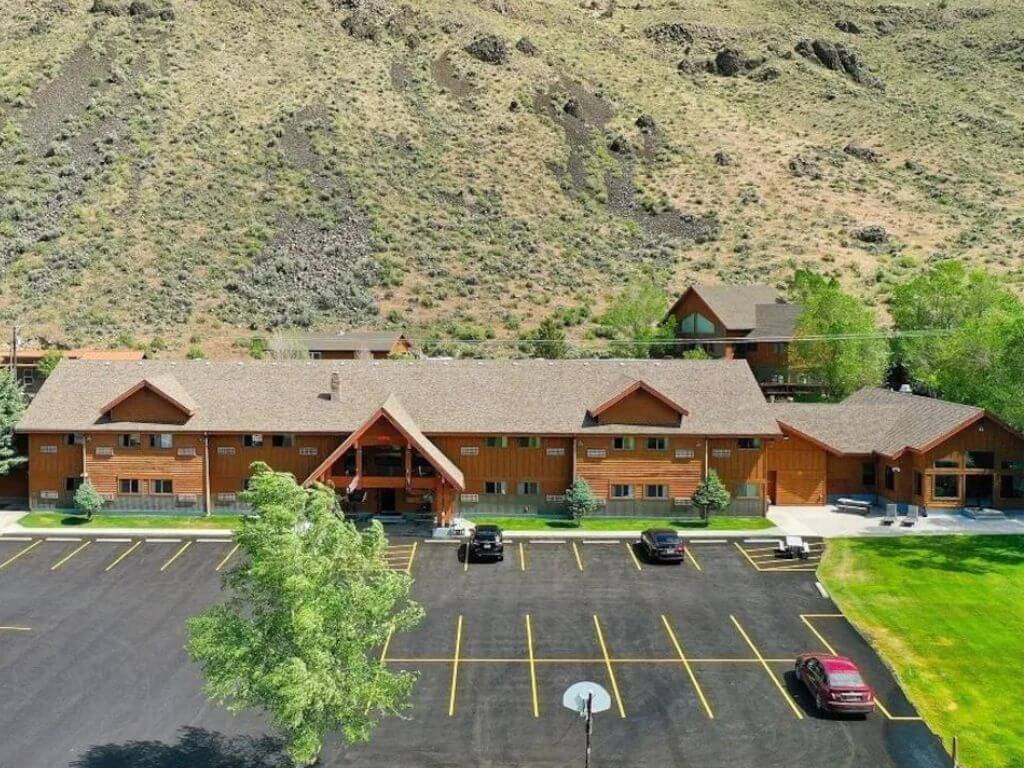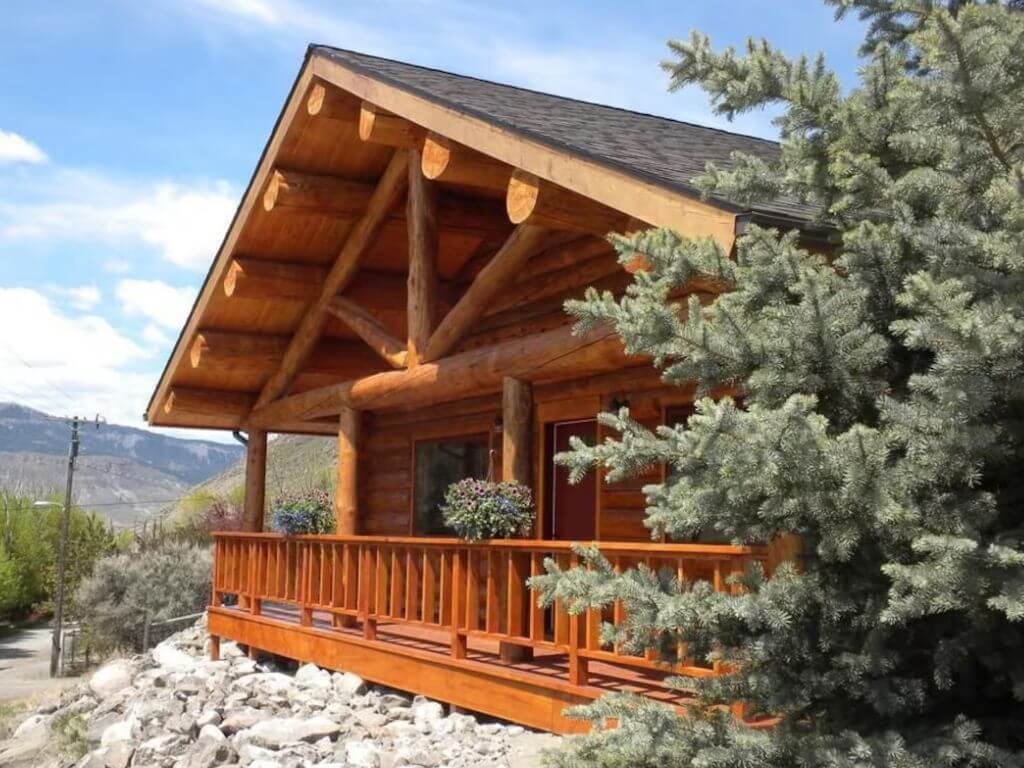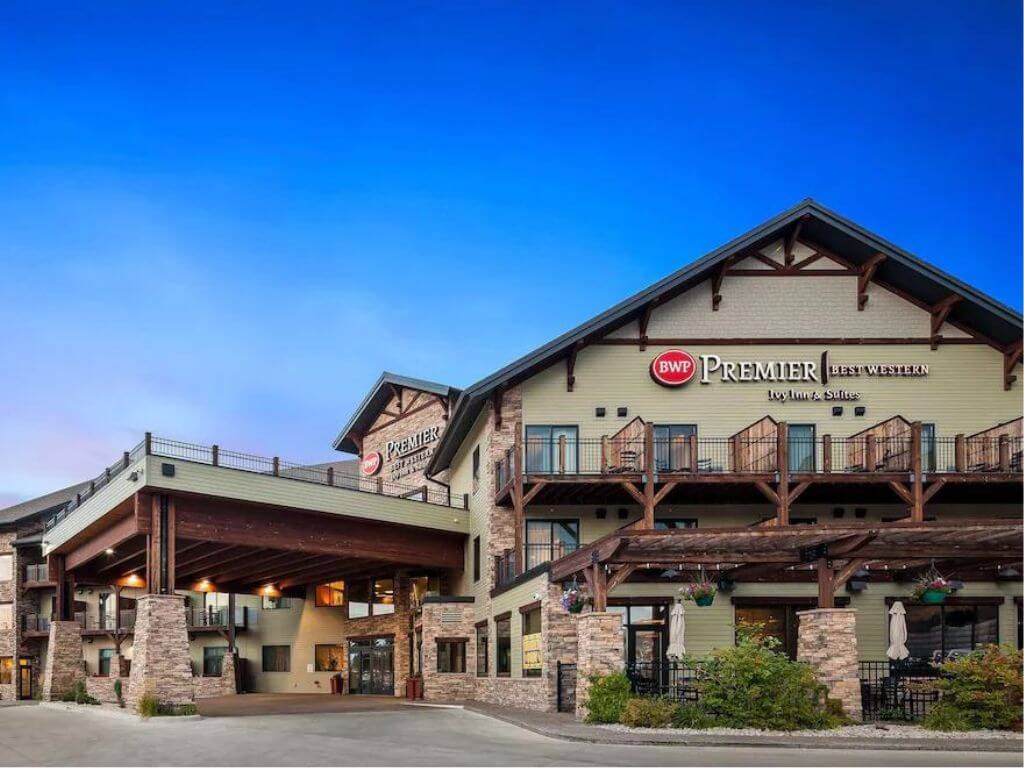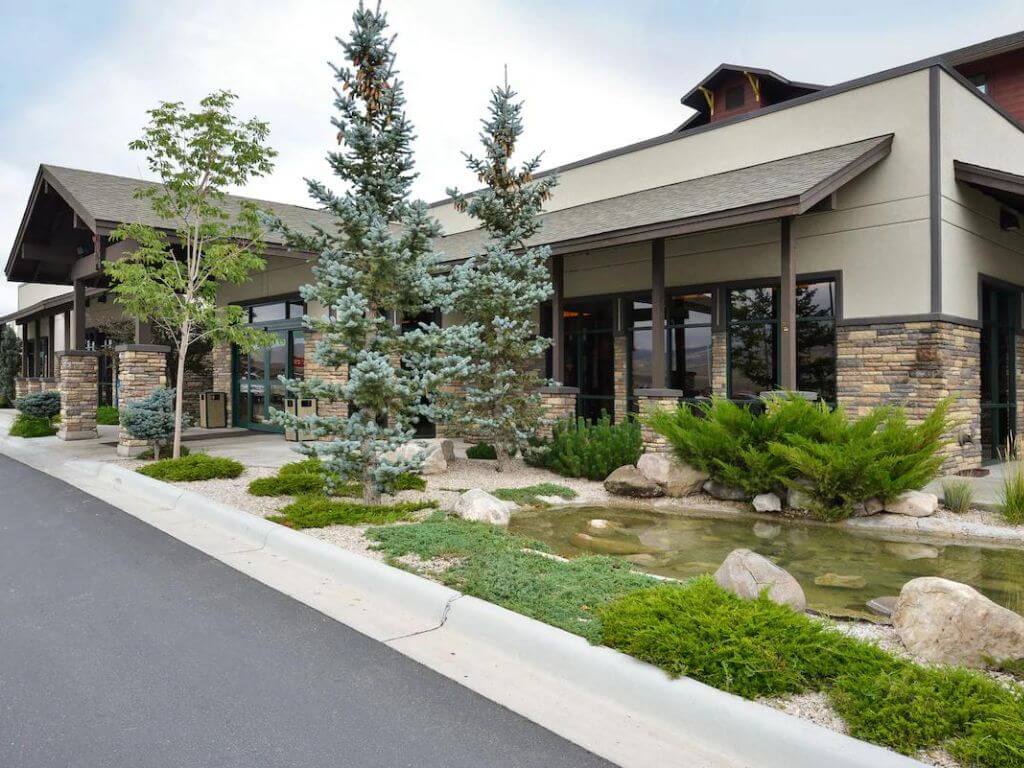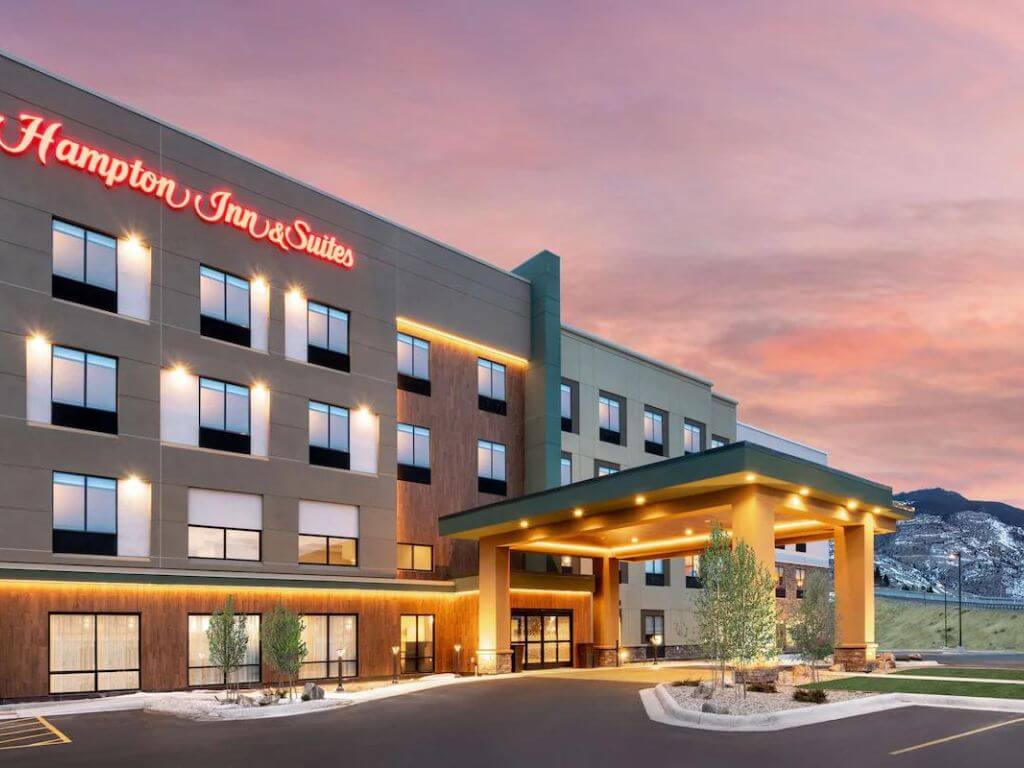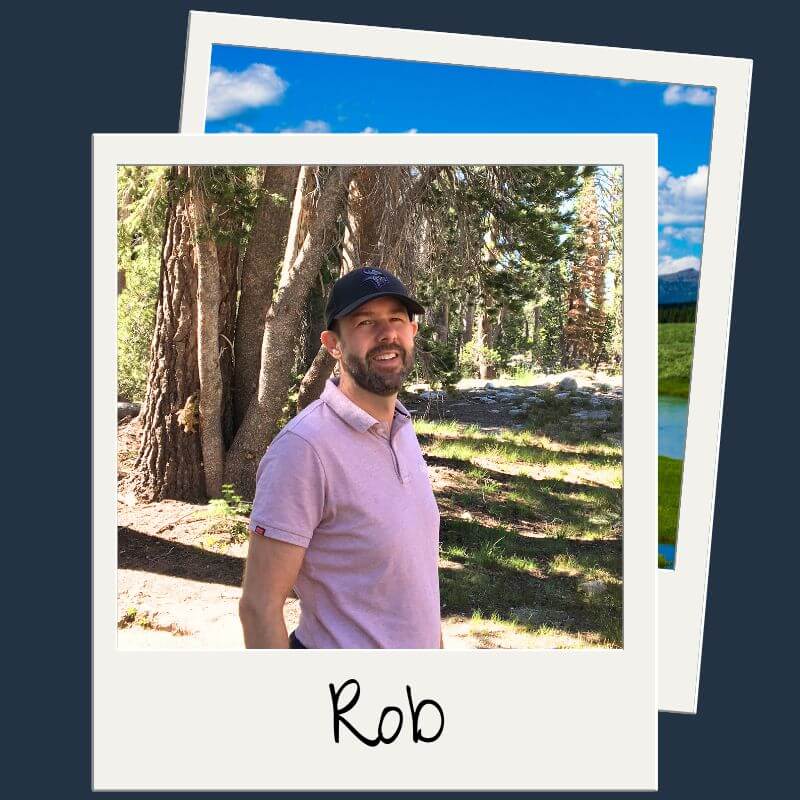Prepare for an exciting Yellowstone road trip itinerary that leads you through the wonders of this remarkable national park.
In this guide, we'll detail a week-long itinerary that highlights Yellowstone's must-see attractions (and more).
What makes this adventure even better? You can easily combine it with a visit to Grand Teton National Park too.
In this guide, we'll detail a week-long itinerary that highlights Yellowstone's must-see attractions (and more).
What makes this adventure even better? You can easily combine it with a visit to Grand Teton National Park too.
7-Day Yellowstone Itinerary At a Glance
Day 1: Geothermal Wonders
Begin your Yellowstone journey with a visit to Old Faithful and the Upper Geyser Basin. Witness Old Faithful's eruptions every 90 minutes, explore the colorful Grand Prismatic Spring, and discover unique features in the Lower Geyser Basin.
Day 2: Norris Geyser Basin, Artist Paint Pots, Madison Valley, and Firehole Canyon
Begin at Norris Geyser Basin to see hot springs and geysers, including the world's tallest, Steamboat Geyser. In the afternoon, head to Madison Valley for wildlife spotting.
Drive along Firehole Canyon Drive to view lava flows, Firehole Falls, and take a swim in the summer.
Drive along Firehole Canyon Drive to view lava flows, Firehole Falls, and take a swim in the summer.
Day 3: Explore the Grand Canyon of Yellowstone
Visit the Grand Canyon of Yellowstone, a stunning geological wonder carved by the Yellowstone River. It stretches for 20 miles and reaches depths of 1,200 feet, featuring iconic waterfalls like the Lower and Upper Falls.
Hike along the Wapiti Trail to experience the vibrant rock formations and enjoy breathtaking views at Artist Point.
Hike along the Wapiti Trail to experience the vibrant rock formations and enjoy breathtaking views at Artist Point.
Day 4: Yellowstone Lake, West Thumb Geyser Basin, and Elephant Back Mountain Trail
Explore Yellowstone Lake and West Thumb Geyser Basin. You can boat on the lake or hike the 1.5-mile Elephant Back Mountain Trail with great lake views. Don't miss the West Thumb Geyser Basin, featuring unique geothermal wonders.
Day 5: Hike Mount Washburn & Explore Hayden Valley
Start with a scenic hike on Mount Washburn at Dunraven Pass. Look for bighorn sheep and wildflowers on this 6-mile round-trip trail.
In the afternoon, head to Hayden Valley for wildlife viewing. It's a smaller but rich area for bison, elk, wolves, and grizzly bears, especially in summer and early fall.
In the afternoon, head to Hayden Valley for wildlife viewing. It's a smaller but rich area for bison, elk, wolves, and grizzly bears, especially in summer and early fall.
Day 6: Tower Fall & Lamar Valley Wildlife
Morning: Visit Tower Fall, a picturesque waterfall in Yellowstone Park. It's just a short walk from the parking area.
In the afternoon and evening, explore Lamar Valley, known for its abundant wildlife. You can spot bison, pronghorn, deer, eagles, and maybe even bears and wolves.
In the afternoon and evening, explore Lamar Valley, known for its abundant wildlife. You can spot bison, pronghorn, deer, eagles, and maybe even bears and wolves.
Day 7: Explore Mammoth Hot Springs
Spend your last day at Mammoth Hot Springs, where approximately 50 hot springs grace the Upper and Lower terraces, creating stunning travertine terraces and pools.
Don't forget to explore the Albright Visitor Center for Ranger insights on Yellowstone's history and wildlife. For breathtaking panoramic views, take the Bunsen Peak Trail hike.
Don't forget to explore the Albright Visitor Center for Ranger insights on Yellowstone's history and wildlife. For breathtaking panoramic views, take the Bunsen Peak Trail hike.
How many days do you need to enjoy Yellowstone National Park?
The number of days you need to fully enjoy Yellowstone National Park can vary widely depending on your interests and the activities you want to pursue. However, a typical visit to see the park's major attractions and highlights might range from 3 to 7 days.
Can you do Yellowstone in a week?
Exploring many of Yellowstone National Park's highlights in a week allows you to immerse yourself in the park's diverse ecosystems, unique geological features, and abundant wildlife.
While a week allows you to explore these attractions and more, it's essential to plan your itinerary carefully to make the most of your time. Additionally, keep in mind that Yellowstone's vastness means there will always be hidden gems and lesser-known areas to discover on future visits.
While a week allows you to explore these attractions and more, it's essential to plan your itinerary carefully to make the most of your time. Additionally, keep in mind that Yellowstone's vastness means there will always be hidden gems and lesser-known areas to discover on future visits.
What is the best month to visit Yellowstone National Park?
Ultimately, the best time to visit Yellowstone depends on your interests and the type of experience you want. If you prefer warm weather and access to all park areas, the summer months are ideal.
If you want fewer crowds and vibrant landscapes, consider spring or fall.
Winter is perfect for a unique snowy experience and solitude, but be prepared for limited amenities.
If you want fewer crowds and vibrant landscapes, consider spring or fall.
Winter is perfect for a unique snowy experience and solitude, but be prepared for limited amenities.
Adventure Without the Effort
Embark on a Group Guided Tour with Everything Included
If you prefer not to plan your own trip, consider joining an organized group tour, where expert guides lead you on excursions, and all accommodations are included for a hassle-free experience.
7 Days Yellowstone National Park Itinerary
This seven-day Yellowstone itinerary is designed for travelers who choose to stay outside of the park, in convenient locations such as West Yellowstone or Gardiner, and then venture into Yellowstone each day to explore its wonders.
Staying outside the park provides access to various accommodations and dining options, making it a practical choice for many visitors.
However, Yellowstone also offers lodging options within the park itself, ranging from rustic cabins to comfortable lodges.
Whether you choose to stay inside or outside the park, this itinerary ensures you can make the most of your Yellowstone adventure.
Staying outside the park provides access to various accommodations and dining options, making it a practical choice for many visitors.
However, Yellowstone also offers lodging options within the park itself, ranging from rustic cabins to comfortable lodges.
Whether you choose to stay inside or outside the park, this itinerary ensures you can make the most of your Yellowstone adventure.
Day 1: Thermal Wonders
Morning: Old Faithful and Upper Geyser Basin
Begin your Yellowstone journey with an early start at the fantastic Upper Geyser Basin, the largest and most densely packed of Yellowstone's geyser basins, featuring the iconic Old Faithful.
Explore the stunning Grand Prismatic Spring, the beautiful Midway Geyser Basin landscapes, and discover unique features at the Lower Geyser Basin on your first day.
Begin your Yellowstone journey with an early start at the fantastic Upper Geyser Basin, the largest and most densely packed of Yellowstone's geyser basins, featuring the iconic Old Faithful.
Explore the stunning Grand Prismatic Spring, the beautiful Midway Geyser Basin landscapes, and discover unique features at the Lower Geyser Basin on your first day.
The driving distance from West Yellowstone to Old Faithful in Yellowstone National Park is approximately 30 miles (48 kilometers).
The driving distance from Gardiner, Montana, to Old Faithful in Yellowstone National Park is approximately 52 miles (84 kilometers)
The driving distance from Gardiner, Montana, to Old Faithful in Yellowstone National Park is approximately 52 miles (84 kilometers)
Old Faithful is undoubtedly Yellowstone's most renowned geyser, known for its impressive eruptions occurring approximately every 60 to 90 minutes, making it one of the park's most predictable natural wonders.
However, this basin features an additional 150 geysers waiting to be explored. Stop by the visitor center to get eruption prediction times for multiple geysers, and strategically plan your route to witness a diverse range of eruptions during your visit.
Embark on a leisurely 2-mile round trip on the paved path starting from Old Faithful Lodge to Morning Glory Pool. Along this scenic route, be sure to pause and admire Castle Geyser, Daisy Geyser, and Riverside Geyser.
Be sure to grab a map from the Visitor Center, and remember to set aside some extra time to explore;
Castle Geyser's remarkable cone, formed by layers of mineral deposits, indicates its ancient age. This geyser erupts at intervals of approximately 9 to 11 hours, propelling a column of water up to 90 feet into the air.
Morning Glory Pool, once a vibrant shade of ultramarine blue, serves as a testament to the fragility of these geothermal wonders. While the pool still retains its striking colors and clarity, the introduction of various objects by unknowing visitors has unfortunately altered and harmed this natural formation.
Beehive Geyser is truly a sight to behold. When it erupts, it can shoot a spectacular column of water up to 200 feet (60 meters) into the air. If you happen to witness it from a distance, simply sit back and relish the short-lived but impressive display, which typically lasts around 5 minutes. Observing Beehive's eruption often depends on luck, as the intervals between eruptions can vary widely, ranging from 8 to 24 hours.
Grand Geyser is another remarkable attraction due to the immense volume of water it spouts, reaching heights of 200 feet during its approximately 10-minute eruptions. However, its eruptions are less frequent, occurring every 6-15 hours, making patience or a stroke of luck necessary. Keep an eye out for the water overflowing and flowing beneath the boardwalk, as this serves as an indicator for an impending eruption.
Riverside Geyser is a short hike or bike ride from Old Faithful, next to the Firehole River. It erupts every 6 hours for about 20 minutes. You can watch it from the other side of the river, and photographers love capturing the rainbows in the spray.
Afternoon: Grand Prismatic Spring & Midway Geyser Basin
As your next stop in the early afternoon, make your way to the Grand Prismatic Spring, a great place to explore.
This area boasts Yellowstone's largest hot spring, the Grand Prismatic Spring, which is an absolute highlight. Its vibrant microbial mats create a stunning contrast of red, orange, yellow, and green along the pool's edges, set against the deep blue center.
To get a close-up view of these captivating colors, take a walk along the extensive boardwalk, although be prepared for occasional steam that may affect your photos.
For a bird's-eye perspective, the Grand Prismatic Overlook Trail, located just south of the Midway Geyser Basin, is a great way to experience the scene. Start your hike at the Fairy Falls Parking lot and follow the 0.6-mile trail with a slight 100-foot elevation gain to reach the overlook.
The Midway Geyser Basin and Grand Prismatic Spring are only a short drive from Old Faithful, making it a seamless addition to your day's itinerary and a great spot for exploration.
Highlights here also include:
Grand Prismatic Spring
Turquoise Pool
Opal Pool
Excelsior Geyser
Firehole River
Later this afternoon, explore the Lower Geyser Basin.
Although not as famous as Grand Prismatic Spring or Old Faithful, these lesser-known attractions are worth a visit. With a more relaxed schedule, you can explore destinations that visitors often overlook when they don't have much time due to a tight schedule.
Try the Fountain Pot Trail, a path winding through the geyser basin, providing views of its main landmarks. Usually, it takes about half an hour to finish the trail, but your journey might take longer if you stop at each attraction to take photos and fully enjoy the natural beauty.
Adventure Without the Effort
Embark on a Group Guided Tour with Everything Included
If you prefer not to plan your own trip, consider joining an organized group tour, where expert guides lead you on excursions, and all accommodations are included for a hassle-free experience.
Day 2: Norris Geyser Basin, Artist Paint Pots, Madison Valley, and Firehole Canyon
The driving distance from West Yellowstone, Montana, to Norris Geyser Basin in Yellowstone National Park is approximately 21 miles (34 kilometers).
The driving distance from Gardiner, Montana, to Norris Geyser Basin in Yellowstone National Park is approximately 16 miles (26 kilometers)
The driving distance from Gardiner, Montana, to Norris Geyser Basin in Yellowstone National Park is approximately 16 miles (26 kilometers)
Morning: Norris Geyser Basin
Named after Yellowstone's second superintendent, Norris Geyser Basin holds the titles of being one of the parks hottest, oldest, and most active hydrothermal areas.
Here, you have two areas to explore:
Back Basin has a 1.5-mile boardwalk and dirt trails where you can see some of the park's unpredictable geysers. Steamboat Geyser, the world's tallest, can shoot up to 400 feet (120 meters), but its eruptions aren't on a set schedule. It became active again in 2019 after being dormant for a while.
Another interesting geyser is Echinus Geyser, named after the spiky deposits left by its spray after eruptions. These acidic geysers, like Echinus, are very rare and have a high pH of about 3.6, close to pure vinegar.
Also in the area:
Emerald Springs
Cistern Spring
Green Dragon Spring
Porkchop Geyser
Minute Geyser
The Porcelain Basin features a shorter 3/4-mile trail made of dirt and boardwalk. Here, you'll observe milky deposits of siliceous sinter, also known as geyserite, rising to the surface and creating a white sheet-like appearance. Interestingly, it can take more than 100 years for just a quarter-inch layer of these deposits to form.
You'll also find located here:
Black Growler Steam Vent
Ledge Geyser
Congress Pool
Blue Geyser
Whirligig and Little Whirligig Geysers
Colorful Water
Whale's Mouth
Emerald Spring
Cracking Lake
In the late morning, visit the Artist Paint Pots, a short and easy trail of just over a mile with a small elevation gain.
Despite its size, this area is rich with hot springs, geysers, a fumarole, and mudpots. The mudpots have lovely colors due to iron oxide, making it a picturesque spot for artists.
As you walk along the trail, it gradually climbs to a lookout point with a great overlook of the thermal area.
In the afternoon:
Explore Madison Valley, which may not be a primary Yellowstone attraction but is incredibly scenic and an excellent spot for wildlife sightings.
Take a Scenic Drive along Firehole Canyon Drive as it traces the Firehole River's course from Madison Junction to a point just above the Cascades of the Firehole.
Along the way, you'll pass by impressive 800-foot thick lava flows and arrive at a viewing area for Firehole Falls, a magnificent 40-foot (12.2-meter) waterfall.
As you continue the drive, you'll come to a swimming area, particularly popular during the peak of the summer season for those looking to cool off.
If you've opted to stay in West Yellowstone, take a right shortly after passing Seven Mile Bridge on your way back and follow Riverside Drive. This route runs alongside the river, offering several stops where you can get out and take in the river's beauty.
Adventure Without the Effort
Embark on a Group Guided Tour with Everything Included
If you prefer not to plan your own trip, consider joining an organized group tour, where expert guides lead you on excursions, and all accommodations are included for a hassle-free experience.
Day 3: Spend a full day at the Grand Canyon of Yellowstone
The driving distance from West Yellowstone, Montana, to the Grand Canyon of the Yellowstone in Yellowstone National Park is approximately 15 miles (24 kilometers).
The driving distance from Gardiner, Montana, to the Grand Canyon of the Yellowstone in Yellowstone National Park is approximately 18 miles (29 kilometers)
The driving distance from Gardiner, Montana, to the Grand Canyon of the Yellowstone in Yellowstone National Park is approximately 18 miles (29 kilometers)
The Grand Canyon of the Yellowstone is a striking geological wonder. It was shaped over thousands of years by the erosive power of the Yellowstone River, carving a deep canyon through volcanic rock.
This canyon spans about 20 miles (32 kilometers) in length and reaches depths of up to 1,200 feet (366 meters).
One of the most iconic features of the Grand Canyon of the Yellowstone is the stunning Lower Falls, which plunges dramatically into the canyon, creating a spectacular waterfall. The Upper Falls, located further upstream, also adds to the canyon's grandeur.
To enjoy these falls fully, there are two viewpoints: one for the Upper Falls and another for the Lower Falls, each with various scenic spots. Make sure to explore as many of these viewpoints as you can during your visit.
Explore the Grand Canyon of Yellowstone by taking a hike on the Wapiti Trail. This trail leads you to the rim of the ancient canyon, which is 10,000 years old and plunges 1,000 feet deep.
As you traverse the canyon's edge, you'll be treated to vibrant rock formations in shades of pink, yellow, red, and orange. The colors become even more vivid with each turn along the trail, culminating in the magnificent Artist Point. This viewpoint offers the most spectacular vantage of the Lower Falls of the Yellowstone River.
Day 4: Explore Yellowstone Lake, West Thumb Geyser Basin, and Elephant Back Mountain Trail
The driving distance from West Yellowstone, Montana, to Fishing Bridge Junction in Yellowstone National Park is approximately 28 miles (45 kilometers).
The driving distance from Gardiner, Montana, to Fishing Bridge Junction in Yellowstone National Park is approximately 50 miles (80 kilometers)
The driving distance from Gardiner, Montana, to Fishing Bridge Junction in Yellowstone National Park is approximately 50 miles (80 kilometers)
Morning: Yellowstone Lake
Spend the whole day at Yellowstone Lake and the West Thumb Geyser Basin in the southern part of the park. You can bring your own boat or rent one, or take a guided boat ride on the lake.
The Elephant Back Mountain Trail is a rewarding hike that covers an elevation gain of 800 feet (244 meters) over a 1-½ mile (2.4-kilometer) journey through a dense lodgepole forest.
From this vantage point, hikers are treated to breathtaking panoramic views of Yellowstone Lake and its surrounding area.
You can access this 3.5-mile (5.6-kilometer) lollipop loop trail from a trailhead located one mile (1.5 kilometers) south of Fishing Bridge Junction, with the hike beginning and ending at the same trailhead.
Afternoon: West Thumb Geyser Basin
In the late afternoon, explore the West Thumb Geyser Basin, a smaller but remarkable geothermal area situated on the western shore of Yellowstone Lake.
Some notable geothermal features in West Thumb include the Fishing Cone, a hot spring where early visitors used to catch fish and cook them in the boiling waters, and the Abyss Pool, known for its strikingly deep blue color.
Additionally, the Black Pool and the Thumb Paint Pots are other intriguing features that showcase the range of geothermal activity found here.
Day 5: Embark on a Hike to Mount Washburn and Explore Hayden Valley
The driving distance from West Yellowstone, Montana, to the Dunraven Pass Trailhead in Yellowstone National Park is approximately 54 miles (87 kilometers).
The driving distance from Gardiner, Montana, to Dunraven Pass Trailhead in Yellowstone National Park can vary depending on the specific route you take. Generally, it's approximately 36 to 40 miles (58 to 64 kilometers).
The driving distance from Gardiner, Montana, to Dunraven Pass Trailhead in Yellowstone National Park can vary depending on the specific route you take. Generally, it's approximately 36 to 40 miles (58 to 64 kilometers).
Begin your day with one of Yellowstone's finest hikes, the Mount Washburn trail at Dunraven Pass. Setting off from the Dunraven Pass Trailhead, you'll ascend Mount Washburn on a trail that treats you to spectacular vistas.
Keep an eye out for bighorn sheep and vibrant wildflowers along the way.
The trail commences at the parking lot at Dunraven Pass, located 4.5 miles (7.2 kilometers) north of Canyon Junction. This is a 6-mile (9.6-kilometer) round-trip journey, starting and concluding at the same trailhead.
Afternoon: Hayden Valley
In the afternoon, visit Hayden Valley, a wildlife-rich area in the heart of Yellowstone National Park. Although smaller than Lamar Valley, at just 7 miles in length, Hayden Valley offers excellent opportunities for wildlife viewing.
This grassy landscape, intersected by the Yellowstone River, is a preferred spot for bison during the summer months, especially in August when they're in rut.
Keep an eye out for grizzly bears, particularly in early summer and as fall approaches, when temperatures cool down.
Begin your day with one of Yellowstone's finest hikes, the Mount Washburn trail at Dunraven Pass. Setting off from the Dunraven Pass Trailhead, you'll ascend Mount Washburn on a trail that treats you to spectacular vistas.
Keep an eye out for bighorn sheep and vibrant wildflowers along the way.
The trail commences at the parking lot at Dunraven Pass, located 4.5 miles (7.2 kilometers) north of Canyon Junction. This is a 6-mile (9.6-kilometer) round-trip journey, starting and concluding at the same trailhead.
Afternoon: Hayden Valley
In the afternoon, visit Hayden Valley, a wildlife-rich area in the heart of Yellowstone National Park. Although smaller than Lamar Valley, at just 7 miles in length, Hayden Valley offers excellent opportunities for wildlife viewing.
This grassy landscape, intersected by the Yellowstone River, is a preferred spot for bison during the summer months, especially in August when they're in rut.
Keep an eye out for grizzly bears, particularly in early summer and as fall approaches, when temperatures cool down.
Adventure Without the Effort
Embark on a Group Guided Tour with Everything Included
If you prefer not to plan your own trip, consider joining an organized group tour, where expert guides lead you on excursions, and all accommodations are included for a hassle-free experience.
Day 6: Discover Tower Fall and Explore the Wildlife Haven of Lamar Valley
The driving distance from West Yellowstone, Montana, to Tower-Roosevelt Junction in Yellowstone National Park is approximately 43 miles (69 kilometers).
The driving distance from Gardiner, Montana, to Tower-Roosevelt Junction in Yellowstone National Park is approximately 32 miles (51 kilometers).
The driving distance from Gardiner, Montana, to Tower-Roosevelt Junction in Yellowstone National Park is approximately 32 miles (51 kilometers).
Morning: Tower Fall
In the morning, visit Tower Fall, a beautiful natural wonder just south of the Tower-Roosevelt Junction in Yellowstone National Park.
Tower Fall is famous for its picturesque charm, with a short walk from the parking area leading to a viewpoint where you can see the falls in all their glory. These falls drop 132 feet from Tower Creek into the Yellowstone River.
For those looking to explore further, you can continue past the Tower Fall viewpoint for about 3/4 of a mile to enjoy scenic views of the creek merging with the Yellowstone River.
Afternoon: Lamar Valley
Exploring Lamar Valley during the afternoon and evening is the best time for optimal wildlife viewing.
Often referred to as "America's Serengeti," Lamar Valley is renowned for its abundant wildlife, lush landscapes, and breathtaking panoramas. Thanks to a dependable water source and fertile vegetation, it's a haven for a diverse range of animals that are easily visible.
During your visit, keep an eye out for herds of bison, pronghorn, and deer, as well as majestic bald eagles and osprey soaring overhead. You might also spot creatures like badgers, coyotes, or even grizzly bears in their natural habitat.
You'll often find groups of parked cars along the road, indicating that fellow visitors have spotted bears, wolves, or other fascinating animals in the valley.
Day 7: Discover the Wonders of Mammoth Hot Springs
The driving distance from West Yellowstone, Montana, to Mammoth Hot Springs in Yellowstone National Park is approximately 52 miles (84 kilometers).
The driving distance from Gardiner, Montana, to Mammoth Hot Springs in Yellowstone National Park is approximately 5 miles (8 kilometers).
The driving distance from Gardiner, Montana, to Mammoth Hot Springs in Yellowstone National Park is approximately 5 miles (8 kilometers).
On your last day, explore Mammoth Hot Springs, which is home to approximately 50 hot springs, arranged across two distinct terraces known as Upper and Lower.
These geothermal wonders are in a constant state of transformation, sculpting a remarkable assortment of travertine terraces, cascading pools, and occasionally vibrant mounds.
You can explore the area on boardwalks, allowing for up-close encounters with the thermal features, while the Lower Terrace presents excellent photo opportunities.
Additionally, there's a convenient driving loop that winds through the Upper Terrace, allowing for a scenic tour.
Notably, the striking Liberty Cap formation stands as a sentinel in the region, a tall, slender mound that has since disconnected from its hot water source.
Following your visit to the hot springs, make a quick stop at the Albright Visitor Center. Here, you'll find Park Rangers ready and willing to share captivating insights about the history and wildlife of Yellowstone National Park.
Hikes around Mammoth Hot Springs
The Mammoth Hot Springs area serves as a starting point for several wilderness trails within Yellowstone, including one beautiful hike that leads to the summit of Bunsen Peak.
At the summit, you'll be rewarded with sweeping vistas encompassing the Blacktail Deer Plateau, Swan Lake Flat, Gallatin Mountain Range, and the Yellowstone River Valley.
You can start this hike from Golden Gate. The return journey retraces the same trail, completing a 4.6-mile (7.4-kilometer) round trip that begins and ends at the same trailhead.
As your trip concludes, consider departing the park through the North Entrance, heading towards Gardiner for the next leg of your journey.
Adventure Without the Effort
Embark on a Group Guided Tour with Everything Included
If you prefer not to plan your own trip, consider joining an organized group tour, where expert guides lead you on excursions, and all accommodations are included for a hassle-free experience.
Field Notes & Mooseful Information
Where to Stay at Yellowstone National Park
Accommodation options within Yellowstone National Park include hotels, rustic cabins, and luxury suites. It's essential to book these well in advance, as they often sell out quickly. Reservations typically open on May 1 for the following summer, and it's common for them to be fully booked over a year ahead.
Campgrounds and RV parks are available. To secure a spot at the first-come, first-served campgrounds, especially during peak summer months, arriving early in the morning is advised. Note that many campgrounds in the park have restrictions on RV length.
Choosing to stay outside the park offers a broader range of accommodations and budget options.
Campgrounds and RV parks are available. To secure a spot at the first-come, first-served campgrounds, especially during peak summer months, arriving early in the morning is advised. Note that many campgrounds in the park have restrictions on RV length.
Choosing to stay outside the park offers a broader range of accommodations and budget options.
West Yellowstone (14 miles from Grand Loop Drive):This is the largest community near the park and closest to key attractions like Midway Geyser Basin and Old Faithful. The town is popular due to its variety of lodgings and restaurants.
Lodging suggestions in & near West Yellowstone
Gardiner (5 miles from Grand Loop Drive):Entering Yellowstone from Gardiner is a unique experience, passing under the stately Roosevelt Arch. Nearby attractions include Mammoth Hot Springs and local elk herds.
Lodging suggestions in & near Gardiner (North Yellowstone)
Yellowstone Village Inn and Suites
|
The Roosevelt Hotel Yellowstone
|
Under Canvas North Yellowstone
|
Cody For a taste of the Old West, historic Cody is the place to be. It offers summer rodeos, the Buffalo Bill Center of the West, and western music venues, perfect for those looking to add some cowboy flair to their Yellowstone adventure.
Lodging suggestions in & near Cody (East Yellowstone)
Best Western Premier Ivy Inn & Suites
|
The Cody Hotel
|
Hampton Inn & Suites Cody
|
Search for more places to stay near Yellowstone National Park
How to get to Yellowstone National Park
Yellowstone National Park, primarily located in Wyoming's northwestern corner with small parts in Montana and Idaho, is accessible through five entrances: north, northeast, east, south, and west. Except for the north entrance, all others are closed to vehicles in winter.
The nearest major city to Yellowstone is Bozeman, Montana, approximately a 90-minute drive to the park's north entrance.
West Yellowstone, Montana, located just outside the west entrance, and towns like Cooke City, Gardner in Montana, and Cody in Wyoming, serve as convenient bases for visiting the park.
Yellowstone Airport (WYS) in West Yellowstone, Montana, is the closest airport to Yellowstone National Park, just three miles (4.8 kilometers) from the park's West Entrance.
The Bozeman Yellowstone International Airport (BZN) is the closest international airport to Yellowstone National Park. It's slightly over an hour's drive to the North Entrance near Gardiner, Montana, and under two hours to the West Entrance in West Yellowstone, Montana.
The nearest major city to Yellowstone is Bozeman, Montana, approximately a 90-minute drive to the park's north entrance.
West Yellowstone, Montana, located just outside the west entrance, and towns like Cooke City, Gardner in Montana, and Cody in Wyoming, serve as convenient bases for visiting the park.
Yellowstone Airport (WYS) in West Yellowstone, Montana, is the closest airport to Yellowstone National Park, just three miles (4.8 kilometers) from the park's West Entrance.
The Bozeman Yellowstone International Airport (BZN) is the closest international airport to Yellowstone National Park. It's slightly over an hour's drive to the North Entrance near Gardiner, Montana, and under two hours to the West Entrance in West Yellowstone, Montana.
Getting around Yellowstone National Park
Most visitors to Yellowstone use personal vehicles or a rental car for transportation, as Yellowstone has no public transit system.
When exploring the vast expanse of the national parks, it's crucial to be mindful of the driving distances and potential delays, especially during the peak summer season.
Yellowstone National Park, in particular, covers a large area, and factors like road works, closures, traffic, including wildlife crossings, can affect travel times.
When exploring the vast expanse of the national parks, it's crucial to be mindful of the driving distances and potential delays, especially during the peak summer season.
Yellowstone National Park, in particular, covers a large area, and factors like road works, closures, traffic, including wildlife crossings, can affect travel times.
In summary
Day 1: Thermal Wonders in Yellowstone National Park
Begin your Yellowstone adventure early in the morning at the Upper Geyser Basin, featuring the famous Old Faithful geyser and a plethora of other geothermal wonders. Witness Old Faithful's predictable eruptions every 60-90 minutes, then explore the basin's 150 additional geysers.
Embark on a scenic 2-mile round trip from Old Faithful Lodge to Morning Glory Pool, passing by impressive geysers like Castle, Daisy, and Riverside. Be sure to check eruption times at the visitor center to plan your route accordingly.
Discover the ancient beauty of Castle Geyser, the vibrant colors of Morning Glory Pool, and the sporadic but spectacular eruptions of Beehive Geyser. Grand Geyser, known for its massive eruptions, and Riverside Geyser by the Firehole River are also must-see attractions.
In the afternoon, head to Grand Prismatic Spring and Midway Geyser Basin to marvel at the colorful microbial mats and take a boardwalk walk for close-up views. For a panoramic perspective, hike the Grand Prismatic Overlook Trail nearby.
End your day by exploring the Lower Geyser Basin, including the Fountain Pot Trail, which offers a relaxed stroll through the lesser-known thermal features. Take your time to enjoy the natural beauty and capture stunning photos along the way.
Embark on a scenic 2-mile round trip from Old Faithful Lodge to Morning Glory Pool, passing by impressive geysers like Castle, Daisy, and Riverside. Be sure to check eruption times at the visitor center to plan your route accordingly.
Discover the ancient beauty of Castle Geyser, the vibrant colors of Morning Glory Pool, and the sporadic but spectacular eruptions of Beehive Geyser. Grand Geyser, known for its massive eruptions, and Riverside Geyser by the Firehole River are also must-see attractions.
In the afternoon, head to Grand Prismatic Spring and Midway Geyser Basin to marvel at the colorful microbial mats and take a boardwalk walk for close-up views. For a panoramic perspective, hike the Grand Prismatic Overlook Trail nearby.
End your day by exploring the Lower Geyser Basin, including the Fountain Pot Trail, which offers a relaxed stroll through the lesser-known thermal features. Take your time to enjoy the natural beauty and capture stunning photos along the way.
Day 2: Norris Geyser Basin, Artist Paint Pots, Madison Valley, and Firehole Canyon
Start your day at Norris Geyser Basin, known for its extreme heat, age, and hydrothermal activity. Explore two areas: Back Basin with unpredictable geysers, including the world's tallest, Steamboat Geyser, and Echinus Geyser, known for its spiky deposits. Visit Emerald Springs, Cistern Spring, and more. In the Porcelain Basin, observe milky siliceous sinter deposits and unique geothermal features.
Late morning, head to Artist Paint Pots, a short, picturesque trail with colorful mudpots and thermal features. Enjoy the scenic beauty and a lookout point.
In the afternoon, explore Madison Valley, known for wildlife sightings, and take a Scenic Drive along Firehole Canyon Drive. Admire lava flows, visit Firehole Falls, and cool off at the swimming area during the summer season.
If staying in West Yellowstone, follow Riverside Drive for scenic river views on your way back.
Late morning, head to Artist Paint Pots, a short, picturesque trail with colorful mudpots and thermal features. Enjoy the scenic beauty and a lookout point.
In the afternoon, explore Madison Valley, known for wildlife sightings, and take a Scenic Drive along Firehole Canyon Drive. Admire lava flows, visit Firehole Falls, and cool off at the swimming area during the summer season.
If staying in West Yellowstone, follow Riverside Drive for scenic river views on your way back.
Day 3: Grand Canyon of Yellowstone
Spend a full day exploring the impressive Grand Canyon of the Yellowstone, carved by the Yellowstone River over thousands of years. This 20-mile-long canyon reaches depths of up to 1,200 feet and features the iconic Lower Falls plunging dramatically.
Visit both Upper Falls and Lower Falls viewpoints for stunning perspectives. Hike the Wapiti Trail along the ancient canyon rim to witness vibrant rock formations in various colors, with Artist Point offering a breathtaking view of the Lower Falls.
Visit both Upper Falls and Lower Falls viewpoints for stunning perspectives. Hike the Wapiti Trail along the ancient canyon rim to witness vibrant rock formations in various colors, with Artist Point offering a breathtaking view of the Lower Falls.
Day 4: Yellowstone Lake, West Thumb Geyser Basin, and Elephant Back Mountain Trail
Spend the day exploring Yellowstone Lake in the southern part of the park. Enjoy boating activities, including guided rides or renting a boat. Hike the rewarding Elephant Back Mountain Trail, offering panoramic views of Yellowstone Lake and the surroundings.
Day 5: Mount Washburn Hike and Hayden Valley
Start your day with a remarkable hike up Mount Washburn at Dunraven Pass, offering breathtaking vistas along the way. Keep an eye out for bighorn sheep and colorful wildflowers as you ascend. This 6-mile round-trip trail begins and ends at the Dunraven Pass Trailhead.
In the afternoon, explore the wildlife-rich Hayden Valley, located at the heart of Yellowstone. This smaller but equally rewarding valley offers excellent opportunities for wildlife sightings, particularly bison during the summer months and grizzly bears in early summer and fall when temperatures cool down.
In the afternoon, explore the wildlife-rich Hayden Valley, located at the heart of Yellowstone. This smaller but equally rewarding valley offers excellent opportunities for wildlife sightings, particularly bison during the summer months and grizzly bears in early summer and fall when temperatures cool down.
Day 6: Tower Fall and Lamar Valley Wildlife Haven
Start your morning by visiting the picturesque Tower Fall, located just south of the Tower-Roosevelt Junction. A short walk leads to a viewpoint showcasing the falls' 132-foot drop into the Yellowstone River.
For more adventure, continue on a 3/4-mile hike to witness the creek merging with the river.
In the afternoon and evening, explore Lamar Valley, often called "America's Serengeti," known for its abundant wildlife and stunning landscapes. Keep an eye out for bison, pronghorn, deer, eagles, osprey, and potentially grizzly bears, making it a prime location for wildlife enthusiasts.
For more adventure, continue on a 3/4-mile hike to witness the creek merging with the river.
In the afternoon and evening, explore Lamar Valley, often called "America's Serengeti," known for its abundant wildlife and stunning landscapes. Keep an eye out for bison, pronghorn, deer, eagles, osprey, and potentially grizzly bears, making it a prime location for wildlife enthusiasts.
Day 7: Explore Mammoth Hot Springs and Departure
On your final day, delve into the captivating wonders of Mammoth Hot Springs, featuring around 50 geothermal springs across Upper and Lower terraces.
Witness the ever-changing travertine terraces, cascading pools, and vibrant mounds as you stroll along boardwalks. Don't miss the excellent photo opportunities on the Lower Terrace and the scenic driving loop through the Upper Terrace. Admire the iconic Liberty Cap formation before stopping at the Albright Visitor Center for insights on Yellowstone's history and wildlife.
For those seeking more adventure, embark on a hike to Bunsen Peak from Golden Gate, offering panoramic views of the surrounding landscapes. The 4.6-mile round trip hike concludes your Yellowstone journey.
Witness the ever-changing travertine terraces, cascading pools, and vibrant mounds as you stroll along boardwalks. Don't miss the excellent photo opportunities on the Lower Terrace and the scenic driving loop through the Upper Terrace. Admire the iconic Liberty Cap formation before stopping at the Albright Visitor Center for insights on Yellowstone's history and wildlife.
For those seeking more adventure, embark on a hike to Bunsen Peak from Golden Gate, offering panoramic views of the surrounding landscapes. The 4.6-mile round trip hike concludes your Yellowstone journey.
|
Rob is an experienced independent travel consultant and travel content creator.
His love for travel started as a child, playing travel agent with his grandparents using holiday brochures from the local travel agency. Fast forward over 40 years, and Rob has turned this passion into a career, dedicating his time to helping others plan their dream vacations. He says his happy place is in a cozy cabin by a lake in Oregon, sitting at the bar of a honky-tonk on Broadway in Nashville, or closer to home walking and cycling in the Peak District National Park. |

